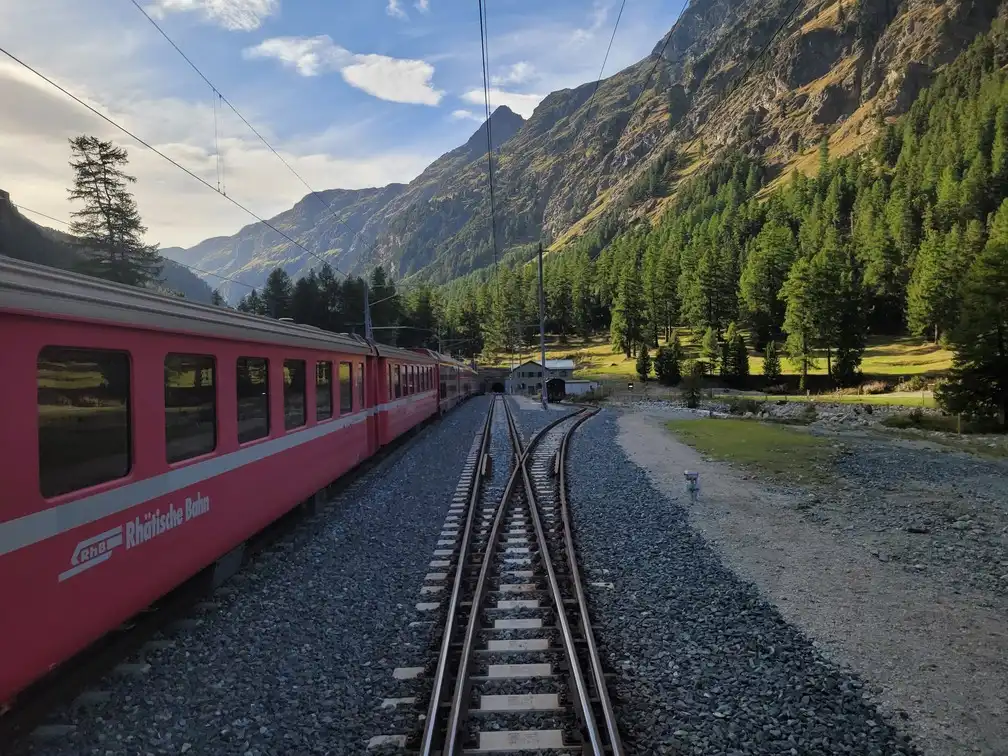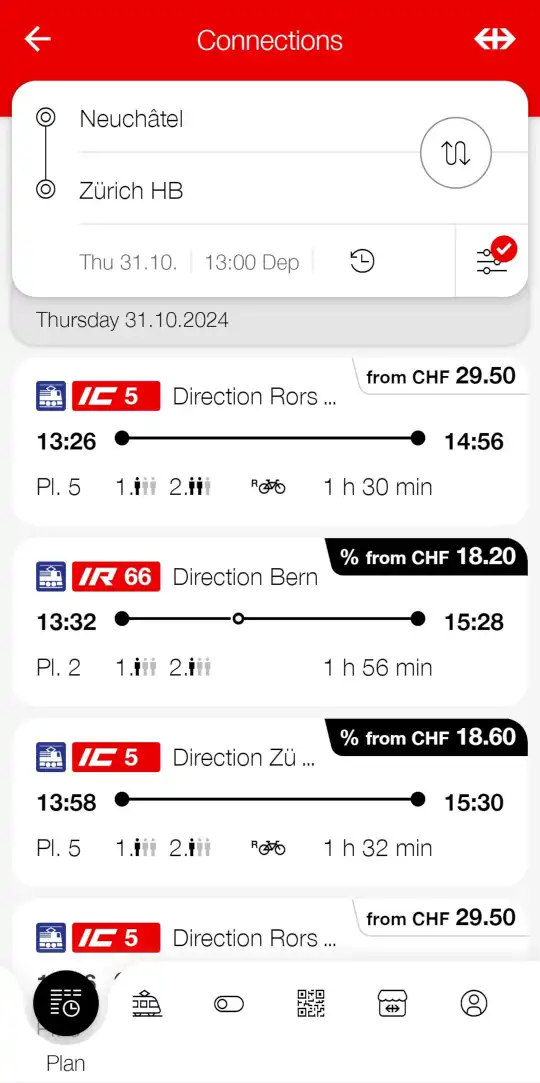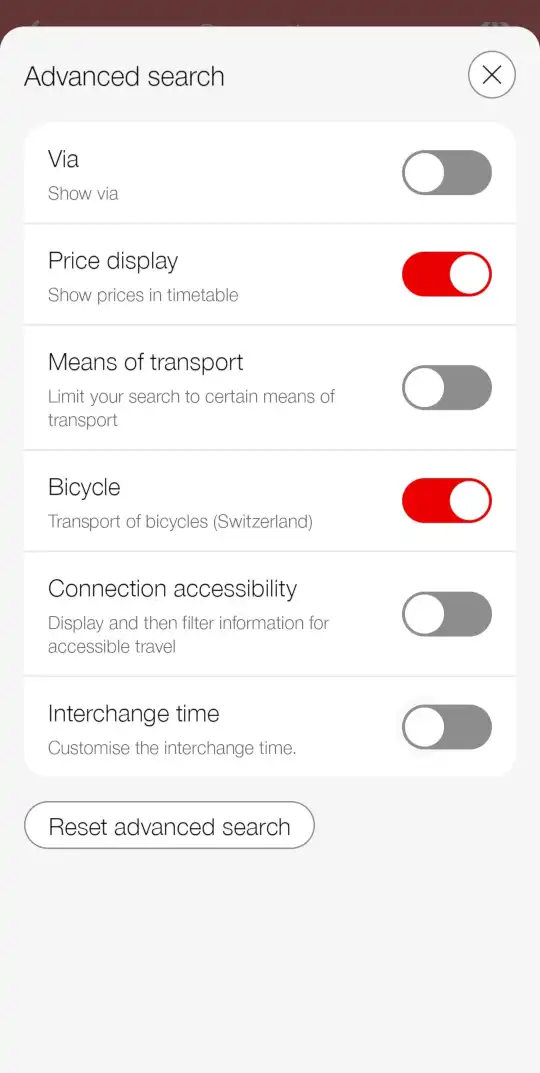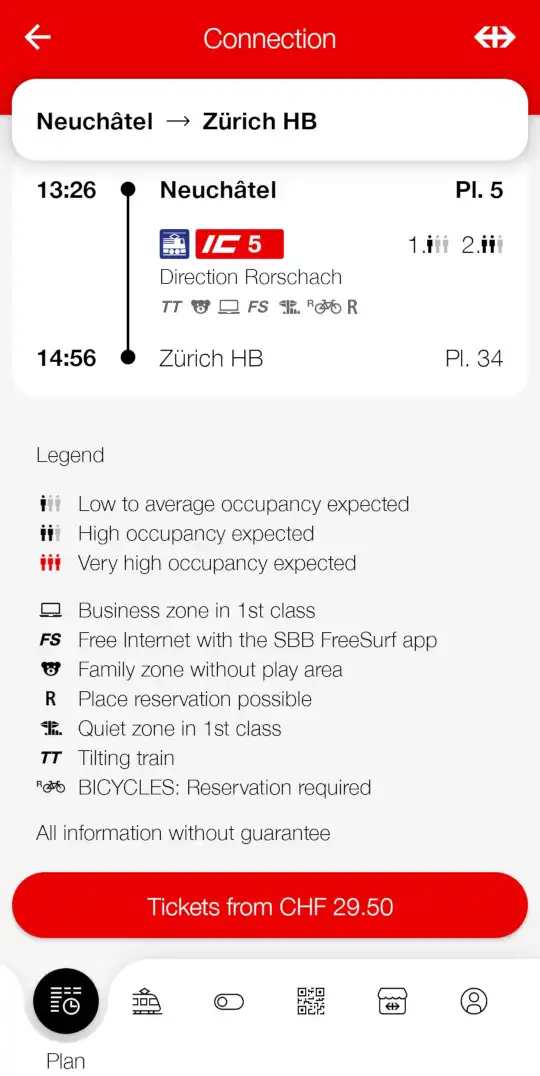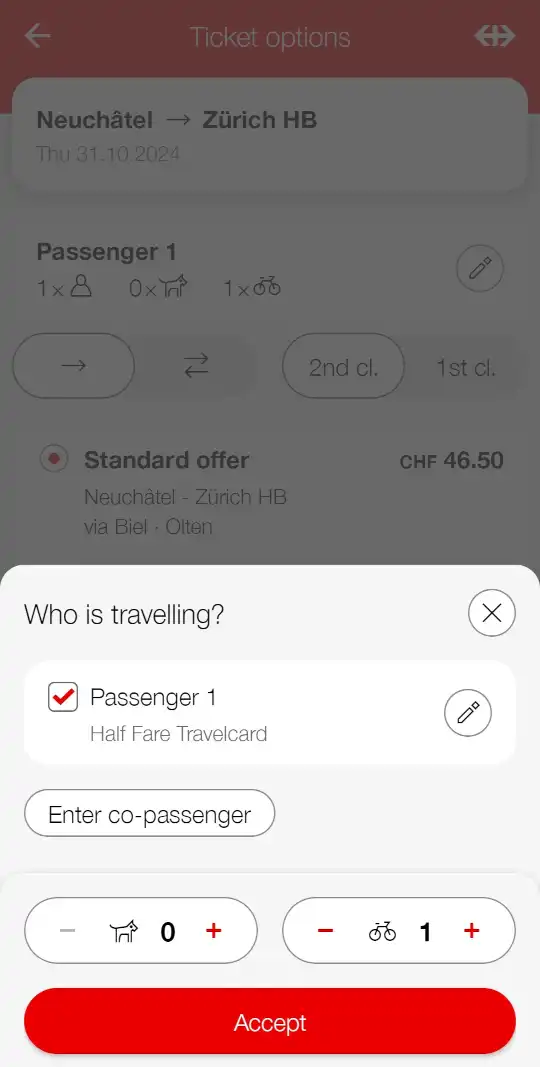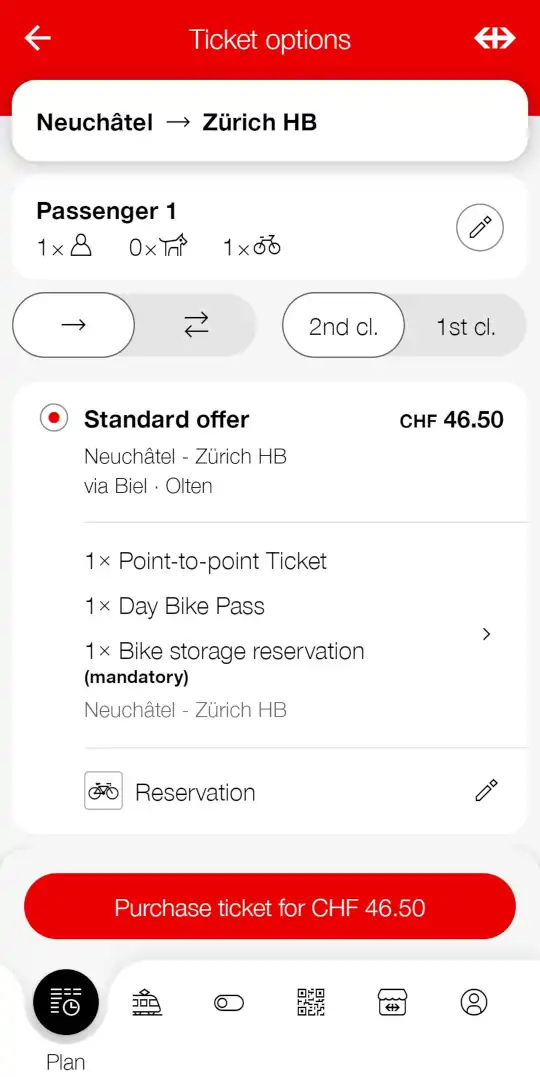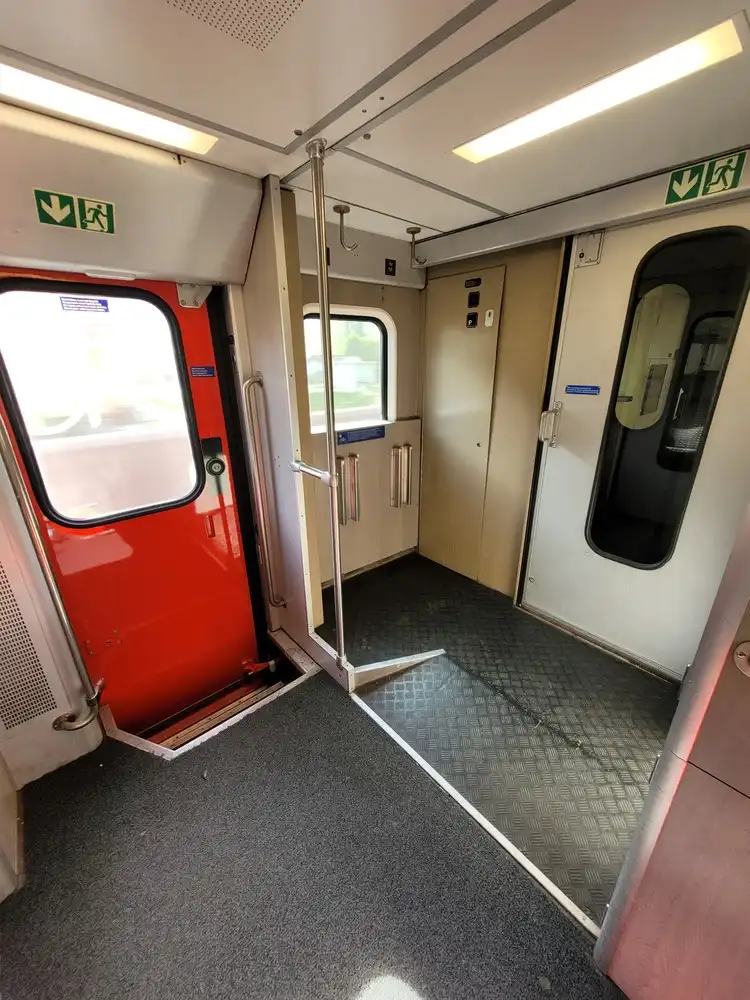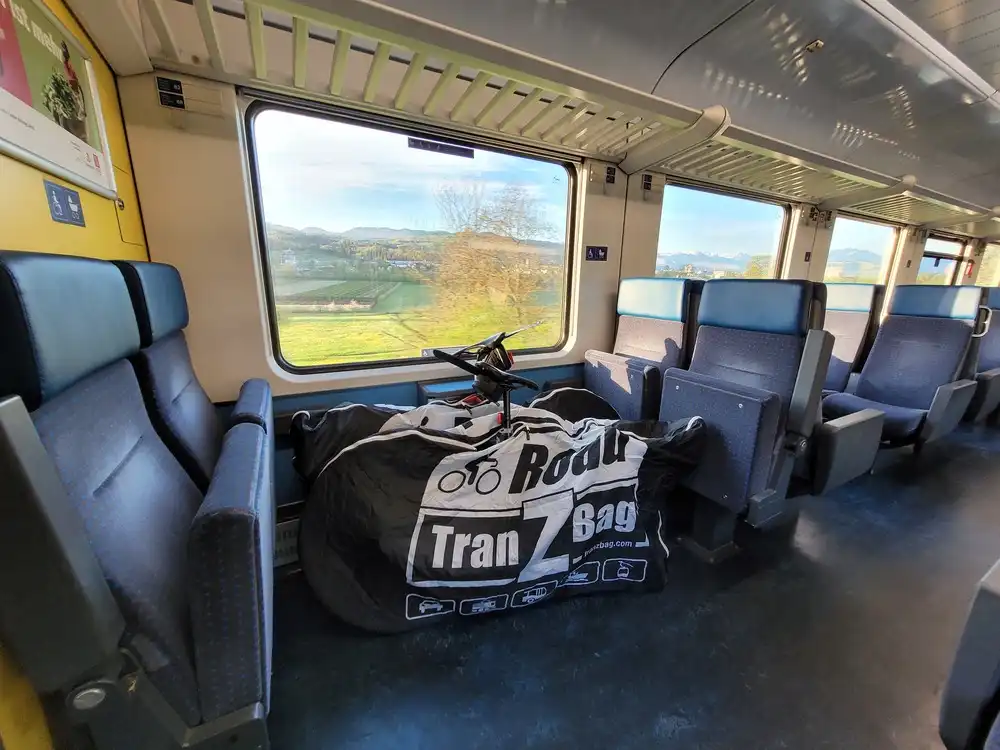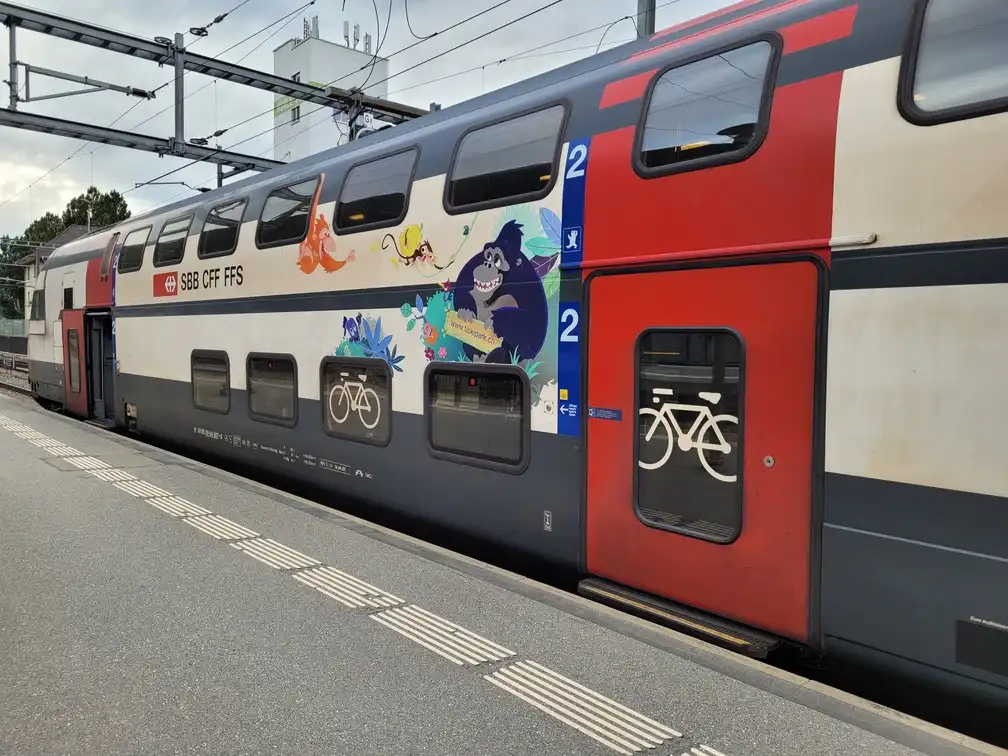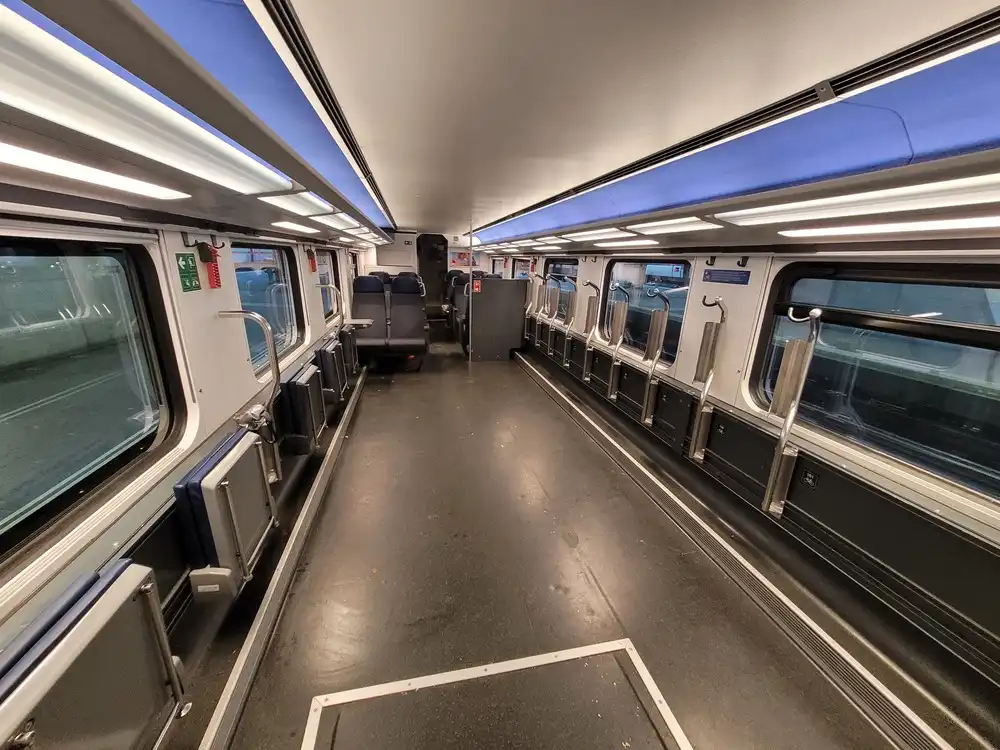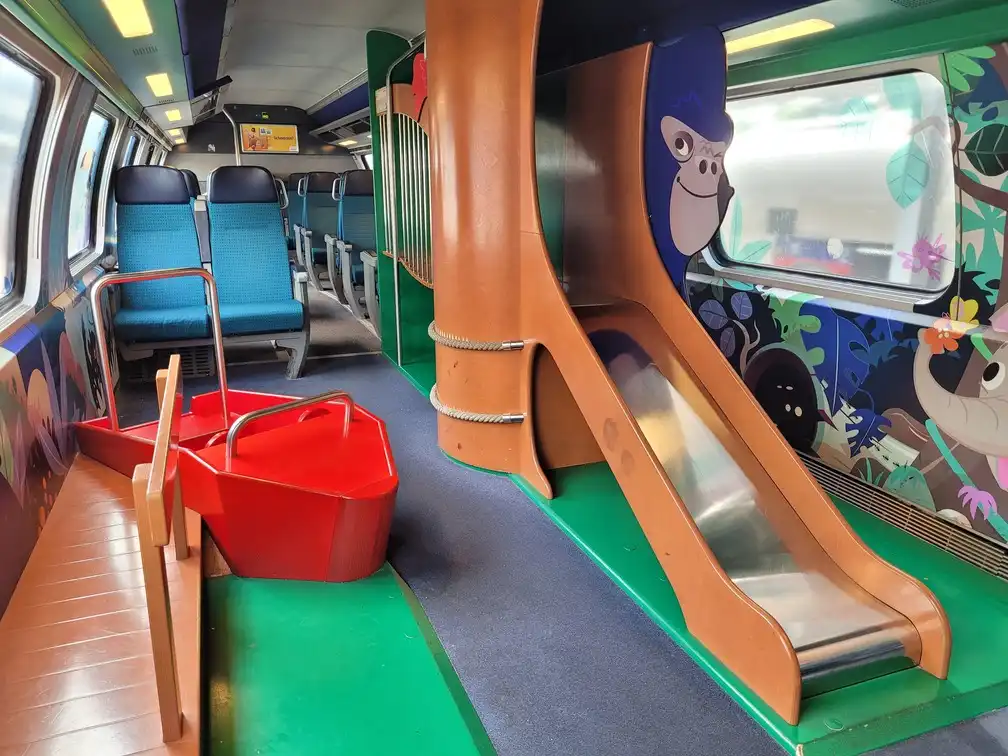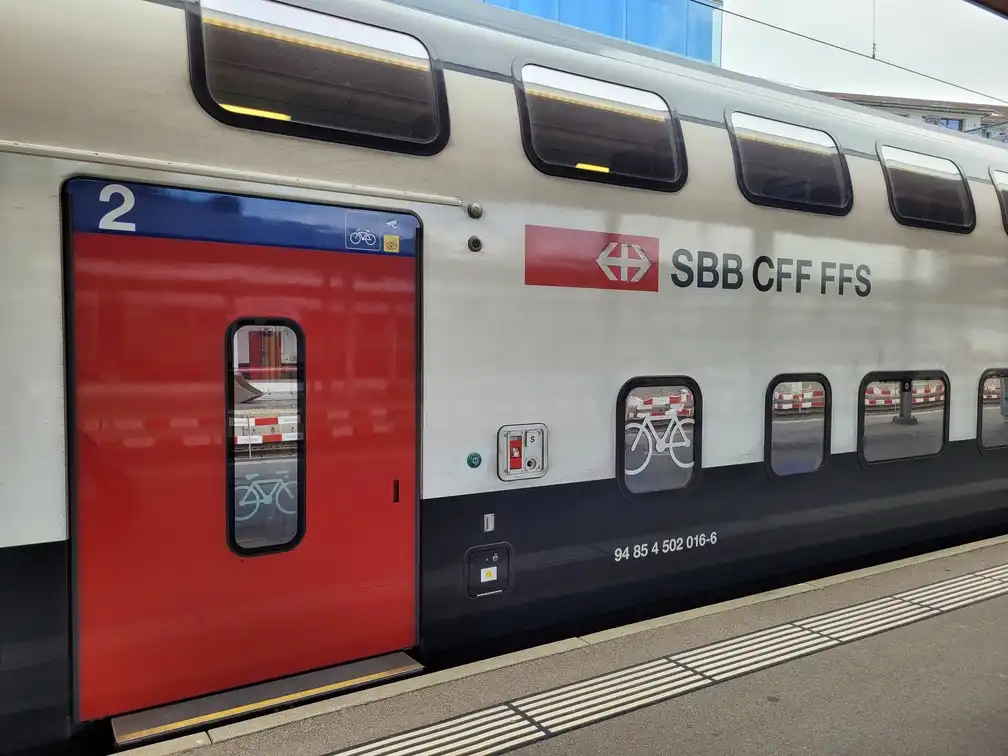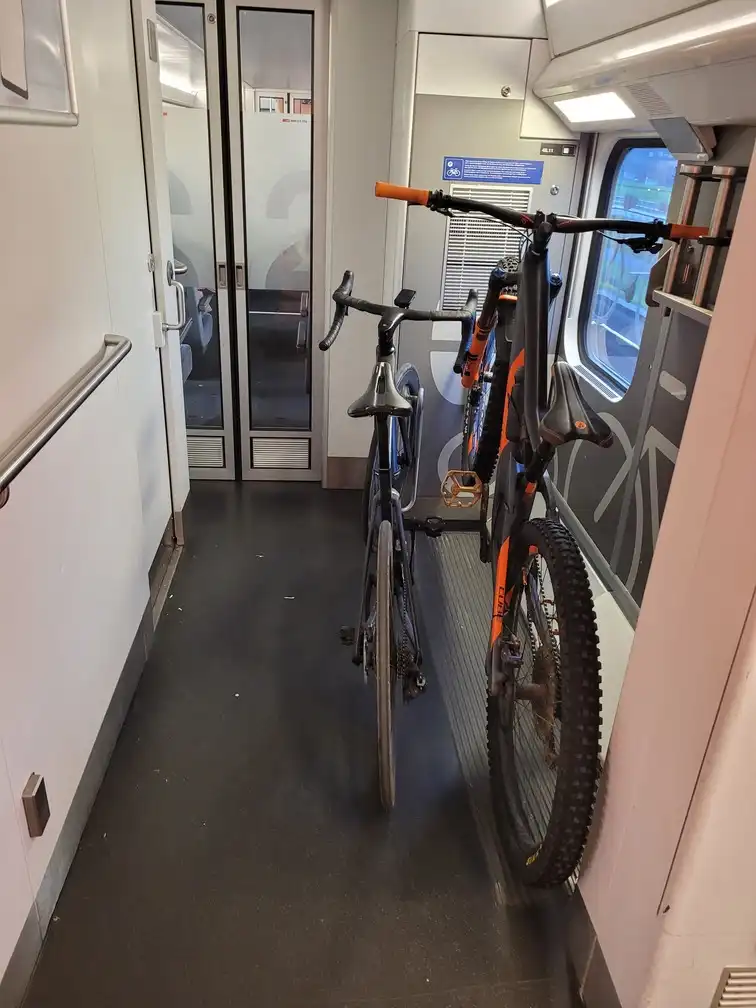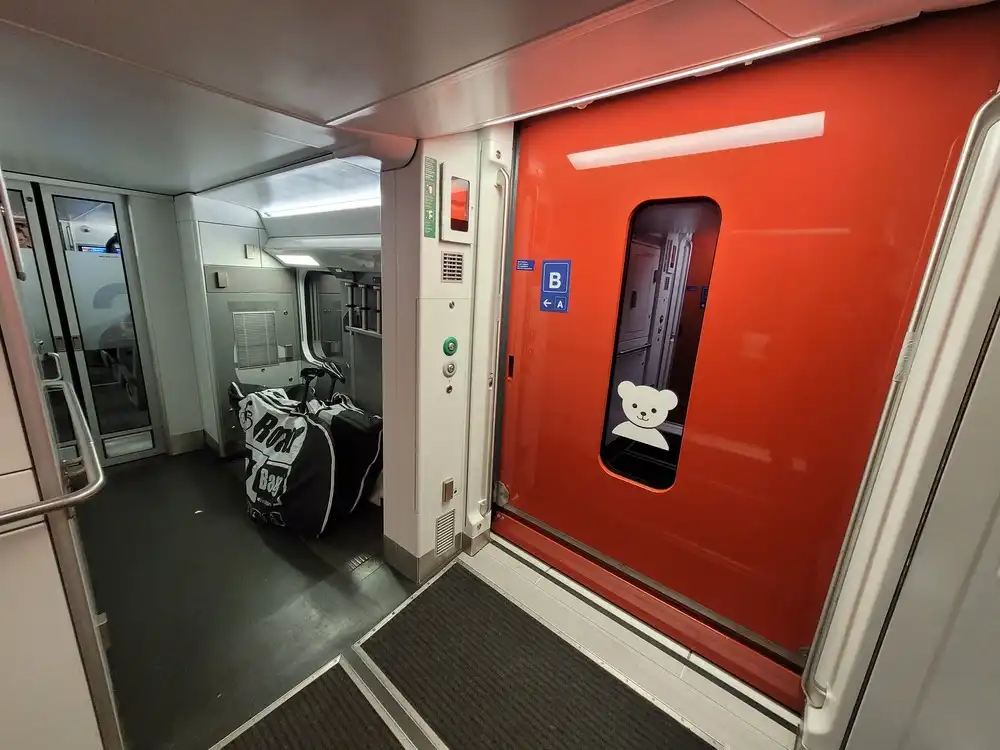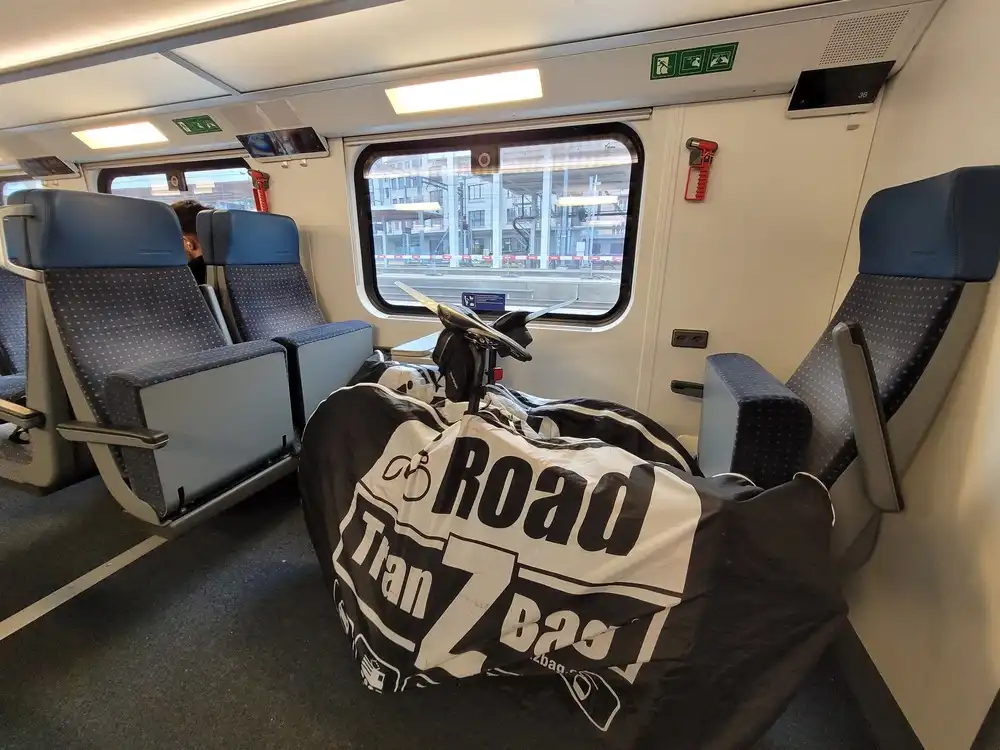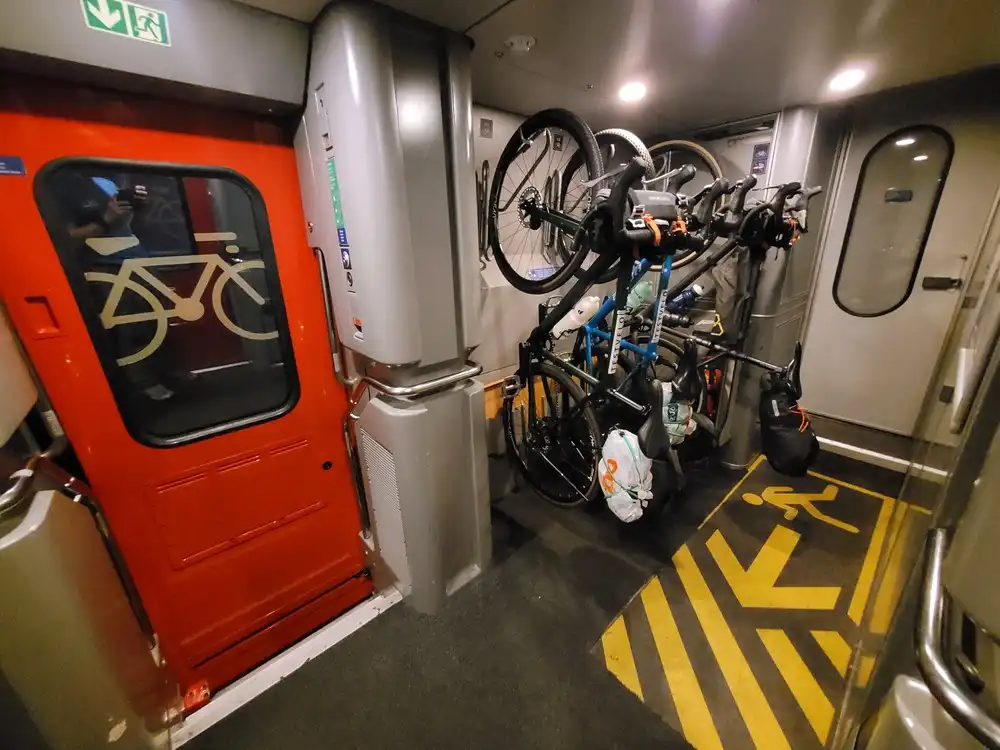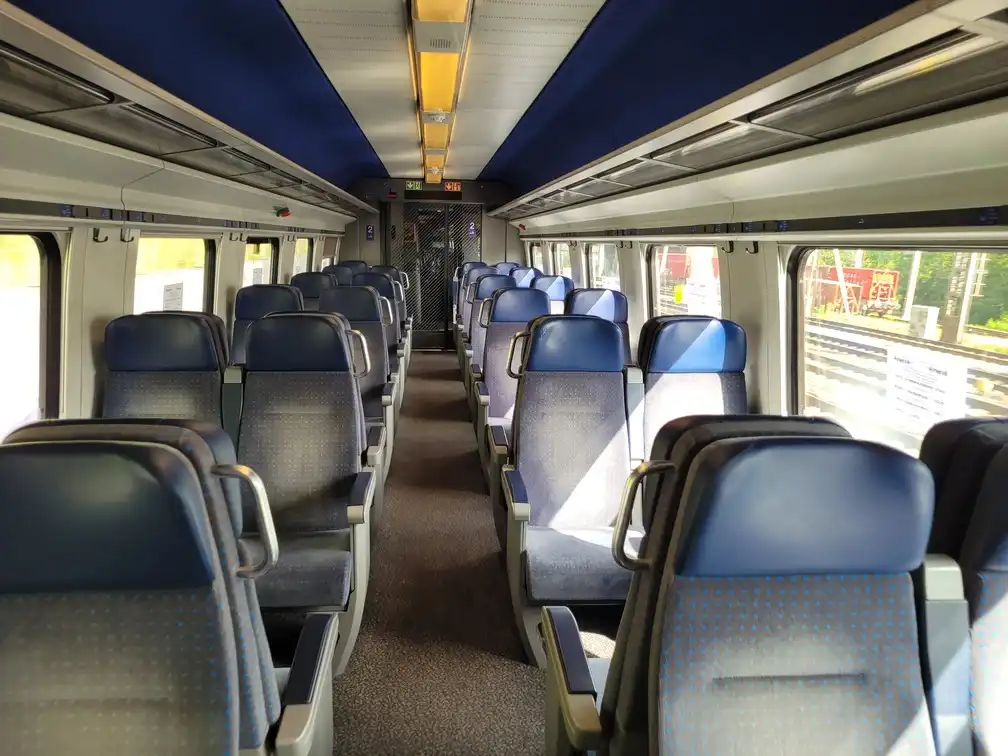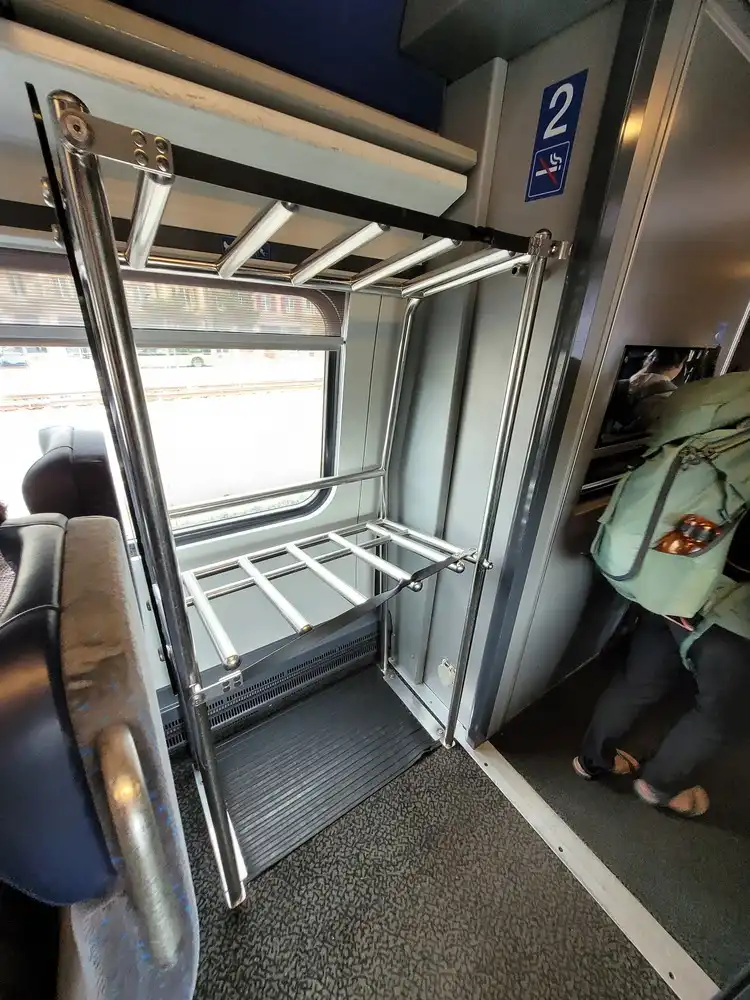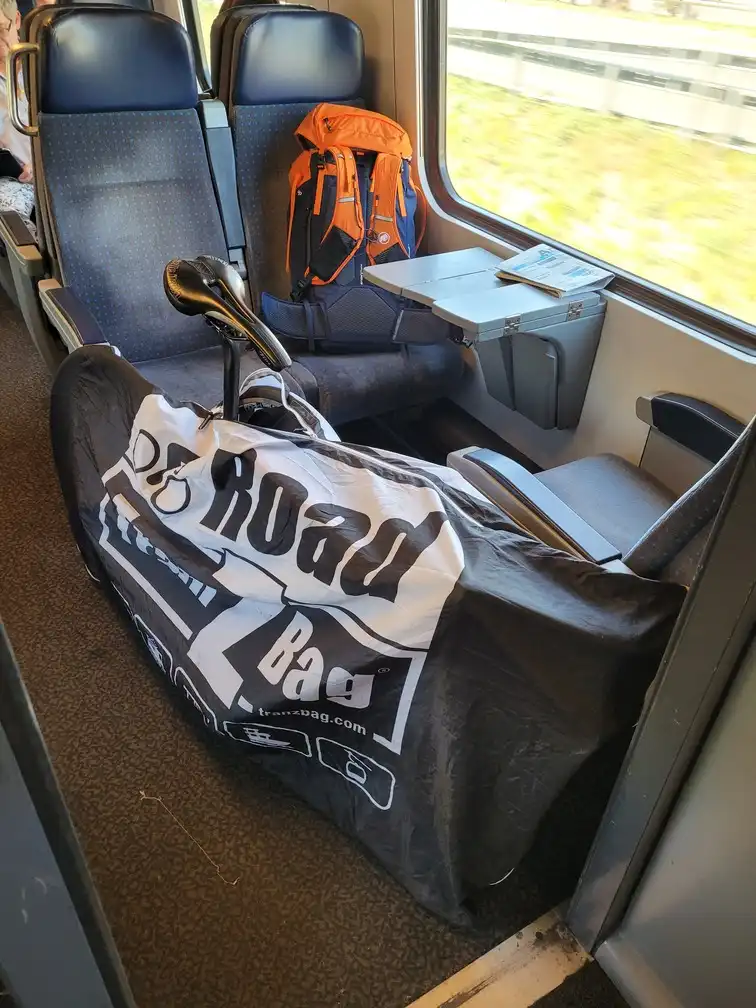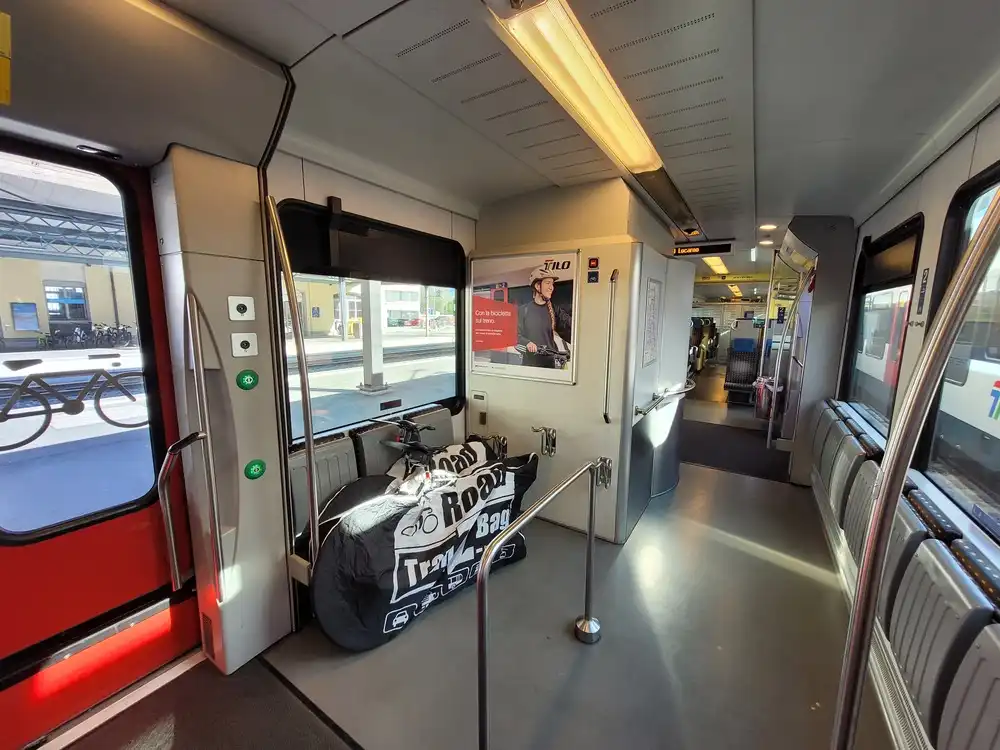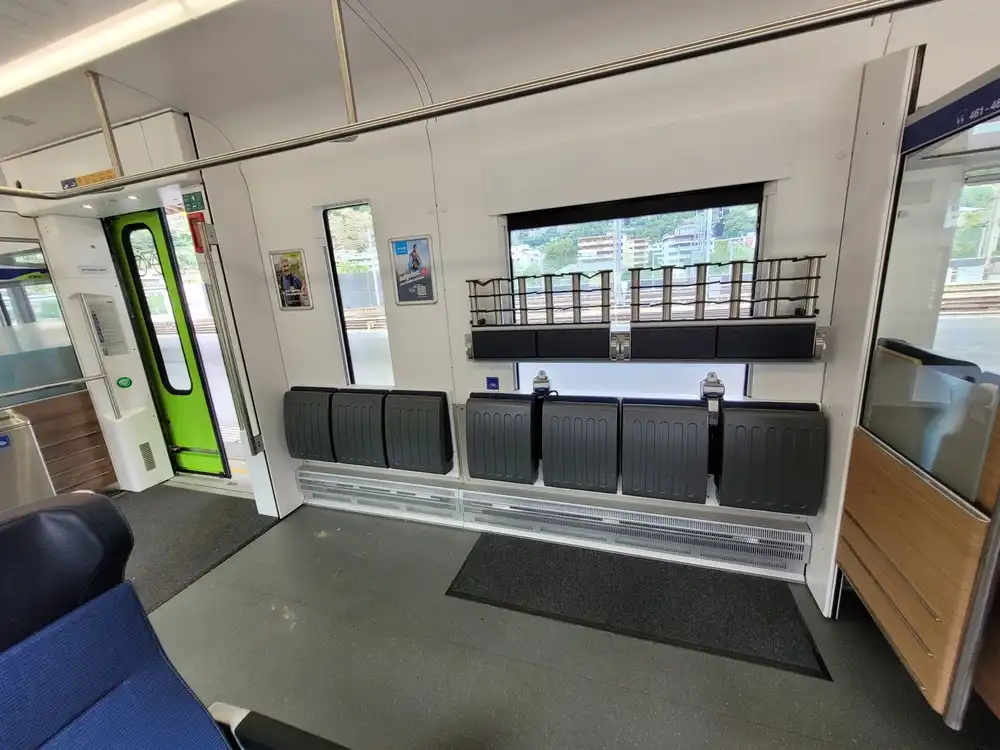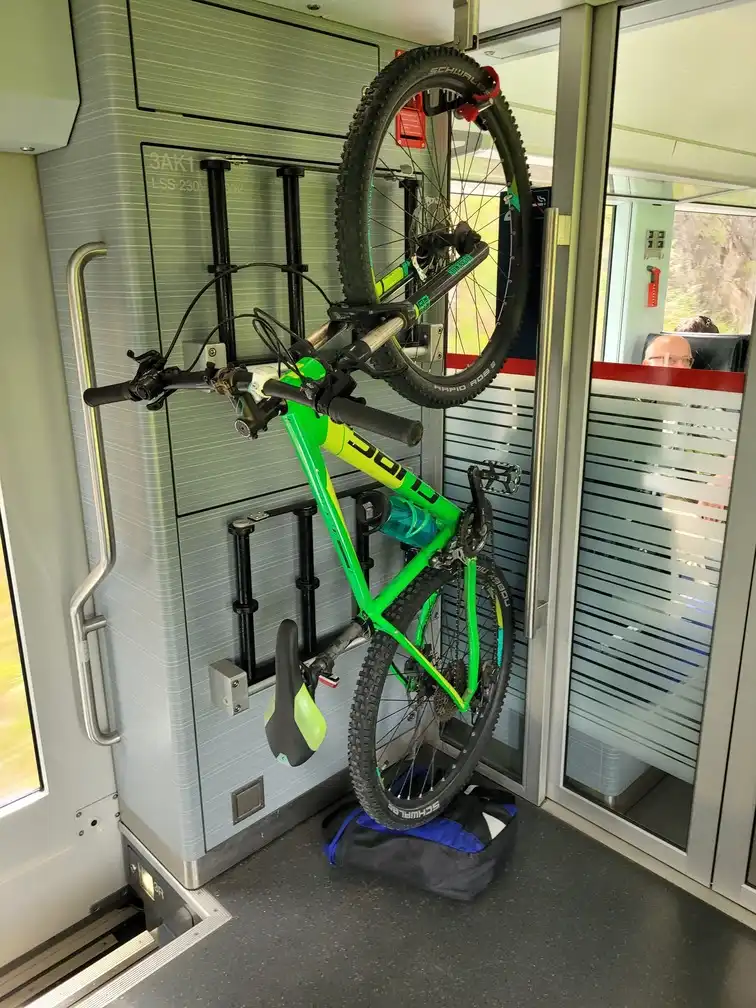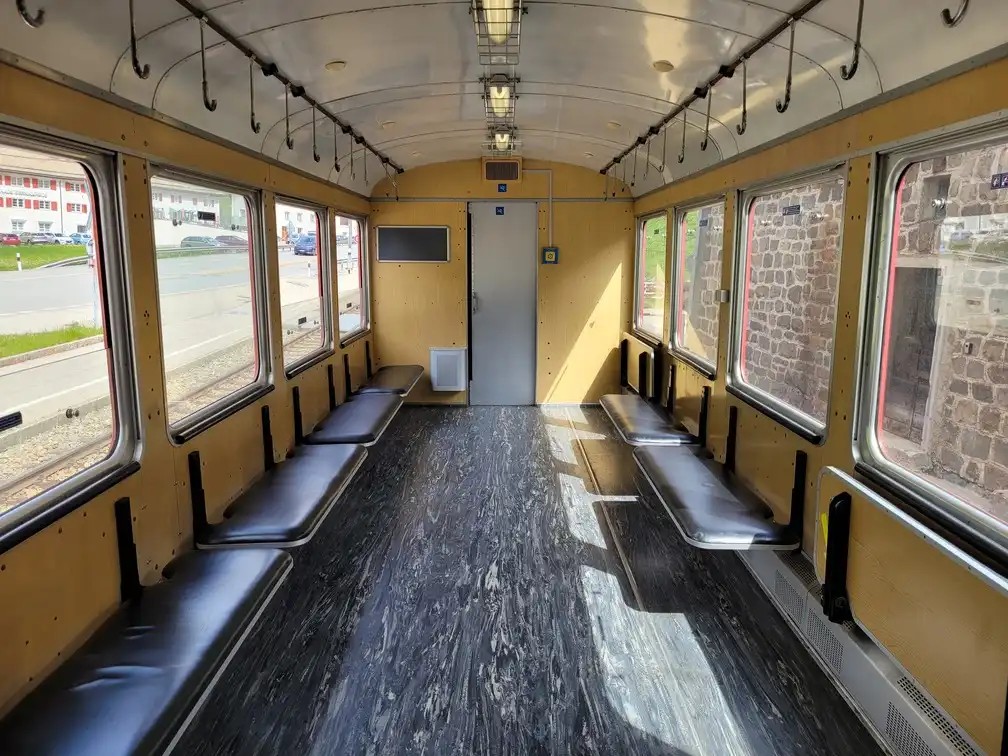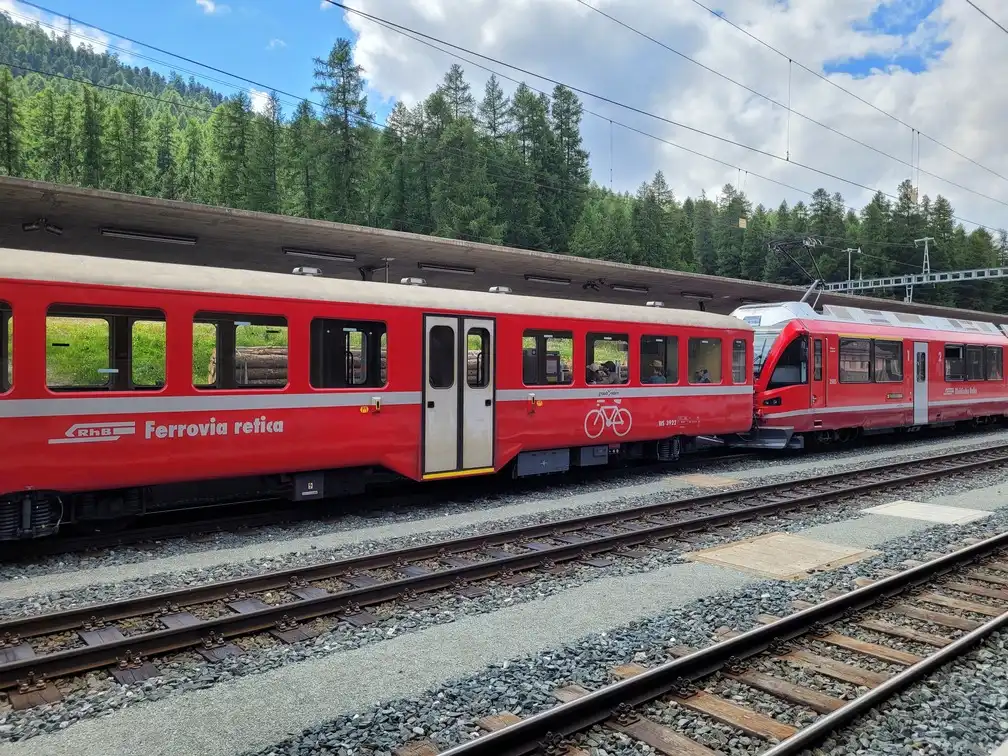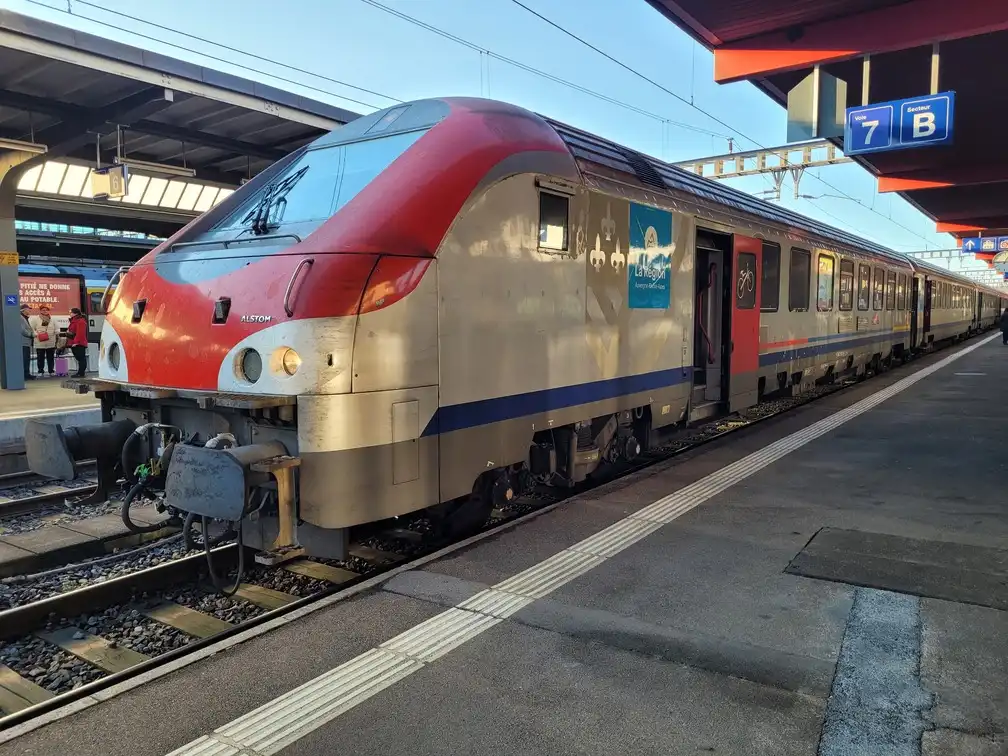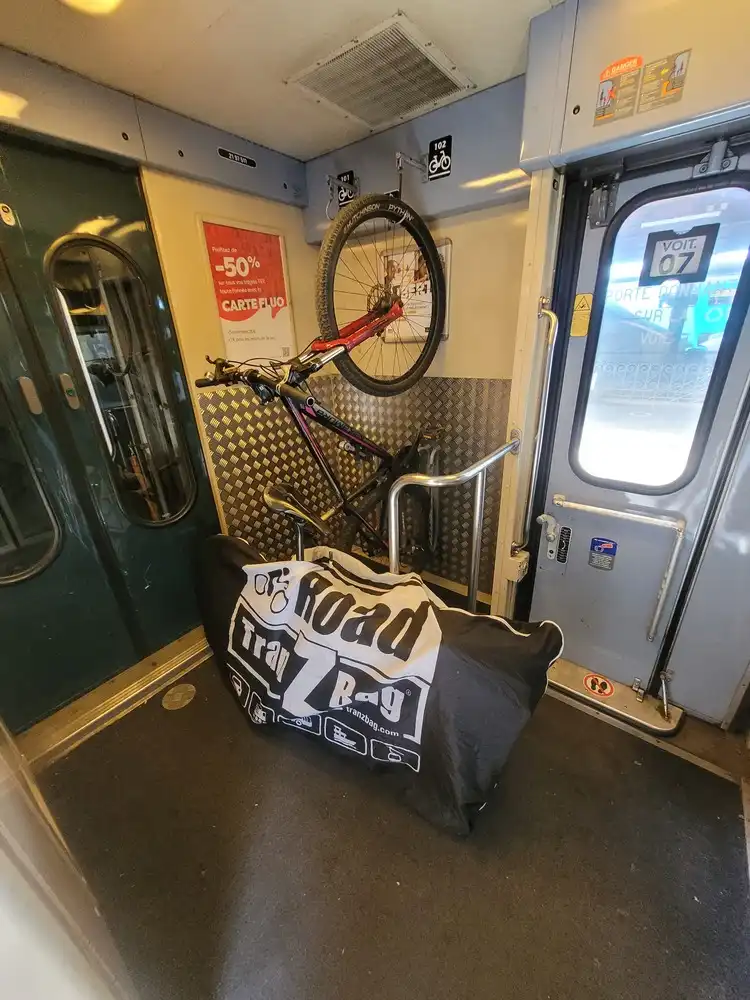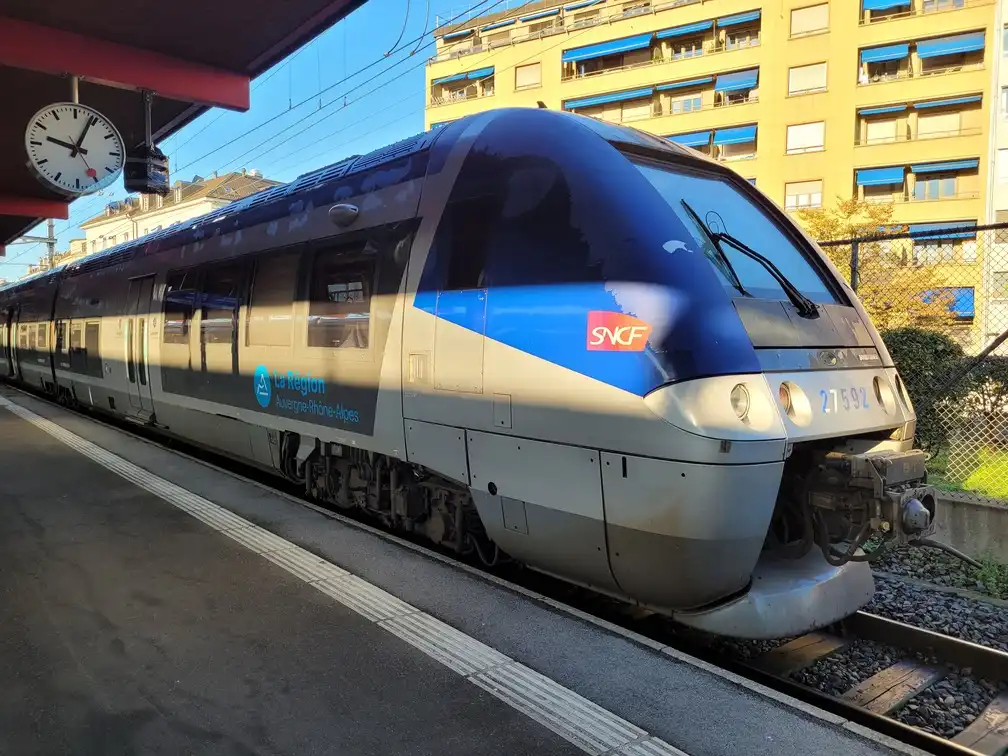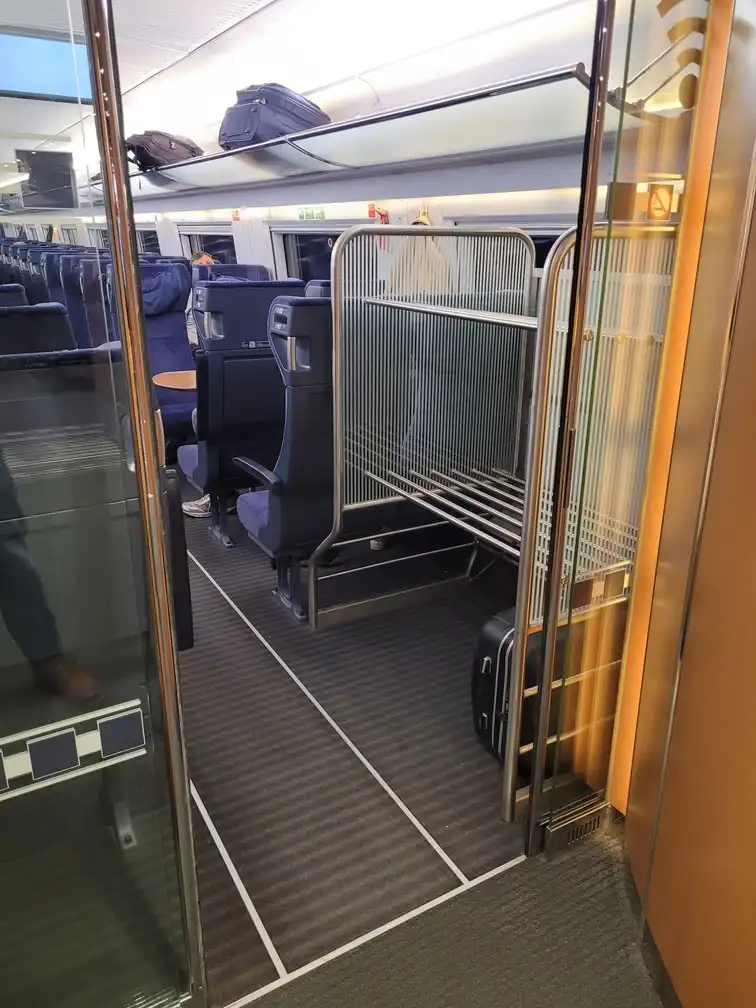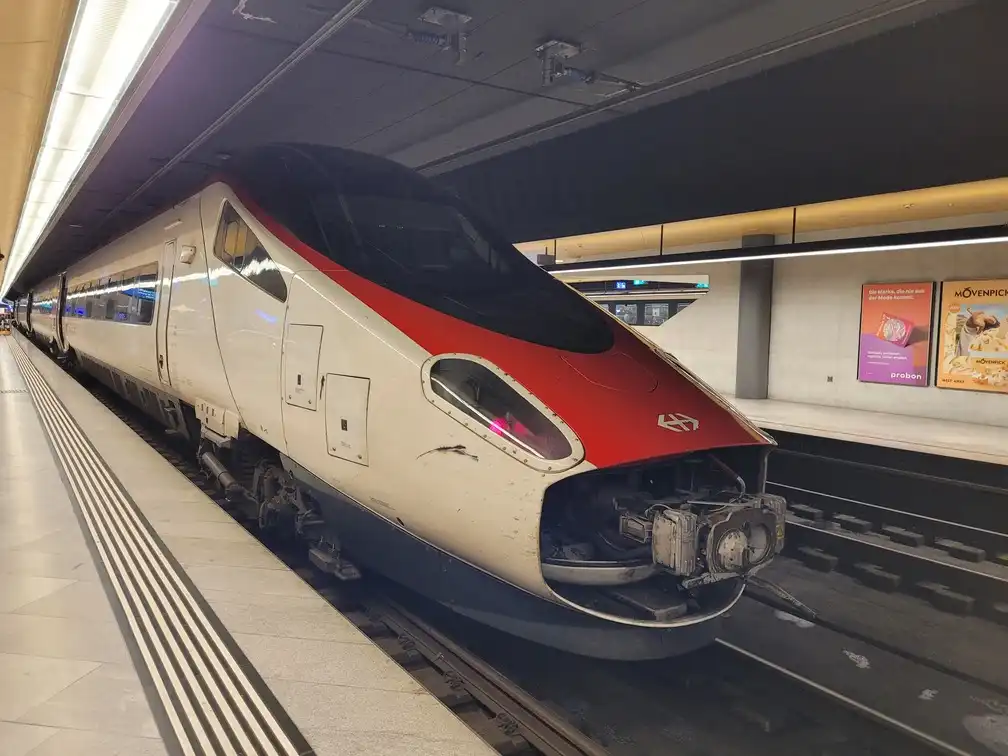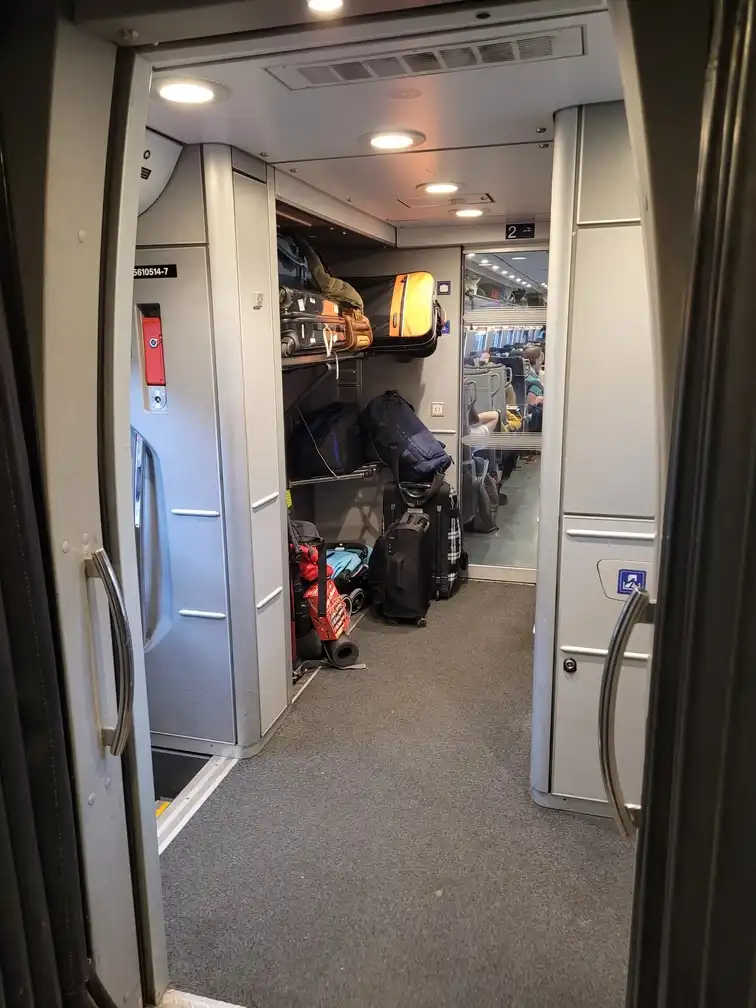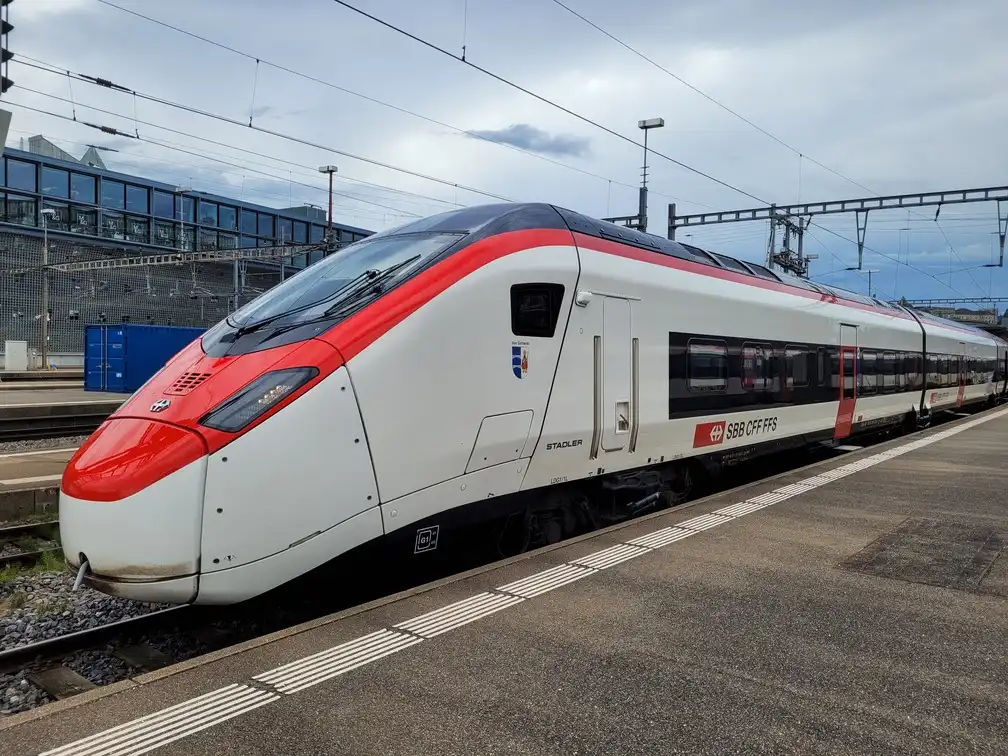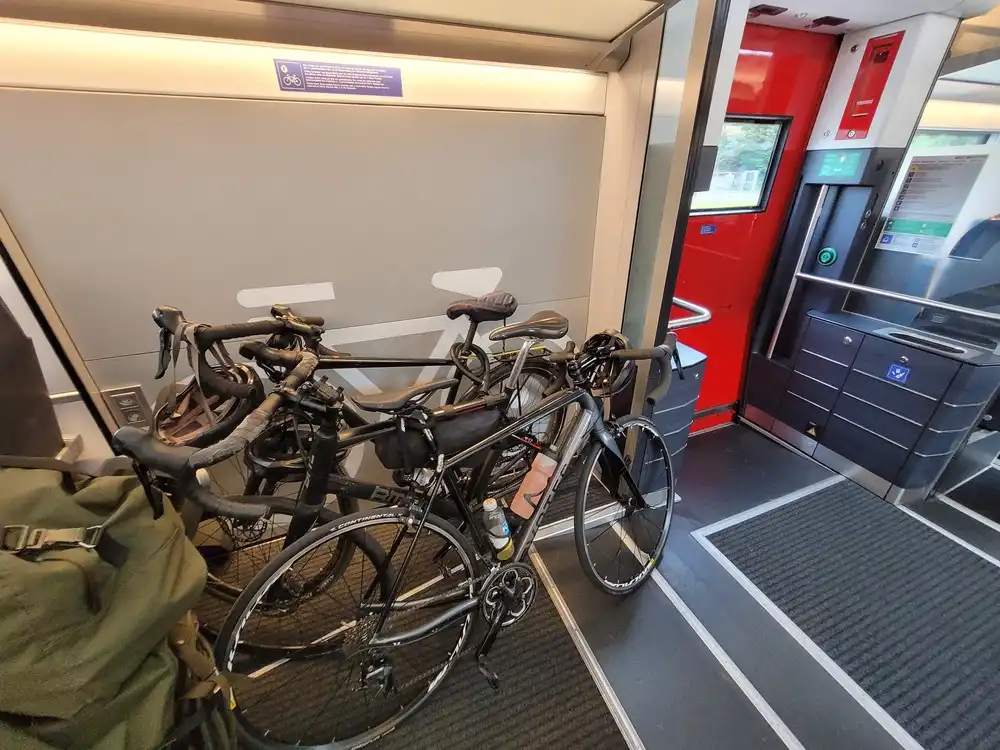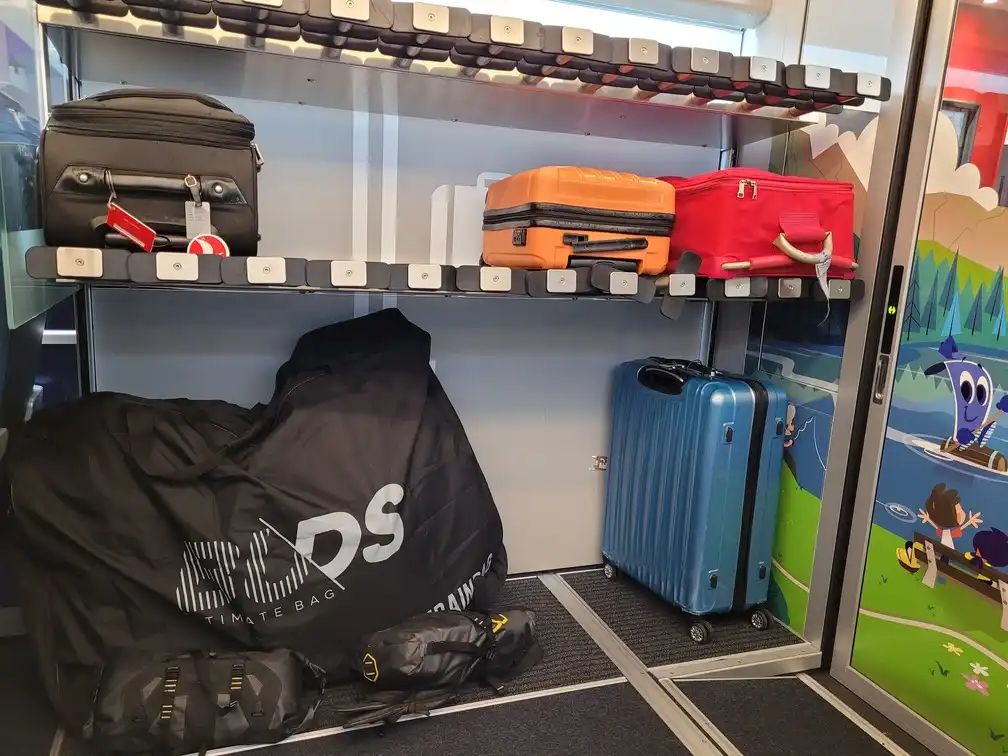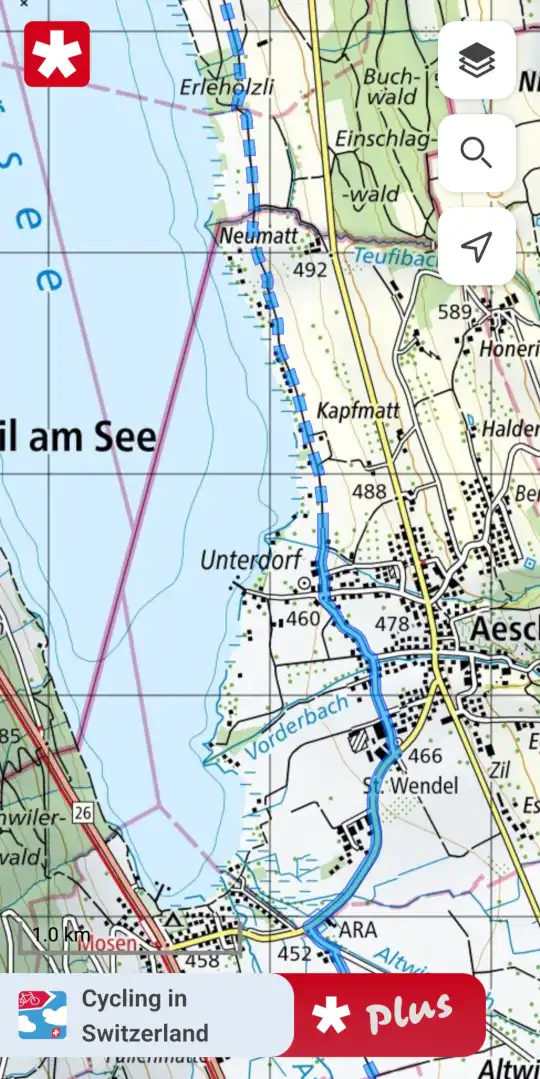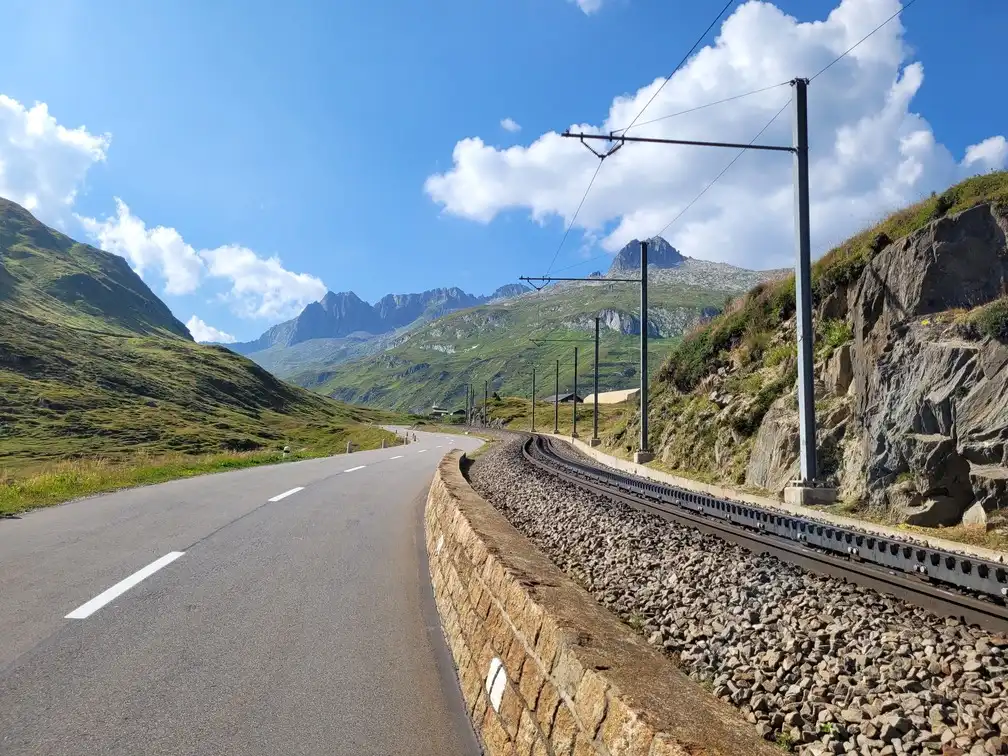A practical guide to bring your bicycle on trains in Switzerland
by
@cycling_on_rails | Strava | RSS
Switzerland is in my opinion one of the best countries to bring a bicycle on a train. It combines frequent and well coordinated services on a dense railway network, a good interior design in most trains and policies that allow taking a bicycle on almost every train.
Policies
The official policy of SBB (the Swiss national railway operator) gives you several options.
- Packed bicycle: You can use any “front wheel removed” bag (SBB has a partnership with the TranZbag brand but any similar model is accepted) to travel on basically any train, for free.
- Assembled bicycle: You pay an additional bicycle ticket (easily available in the SBB app, see below) and can travel on most trains (except some suburban trains at peak hours). Note that a reservation is becoming mandatory on more and more intercity trains, in particular in summer and on week-ends. You can use the SBB app to check if your train requires a reservation, and if so buy one. A reservation is also mandatory for most international routes, however SBB doesn’t offer them so you’ll have to book via the other operator.
- Other: SBB also offers a bicycle shipping service within Switzerland (and a generic luggage shipping service) but it takes a few days and costs extra (although not a crazy price for Switzerland) so I’ve never tried it. They also partner with various bicycle rental services but I never tried them either.
In terms of pricing, the base bicycle ticket costs the same as a half-fare ticket, capped at 15 CHF per day (around 16€). Keep that in mind if you take multiple trains, to avoid paying more than the 15 CHF cap. On top of that, each reservation costs 2 CHF (just above 2€), for trains that require it. If you travel often, you can also buy a yearly bicycle pass for 260 CHF (around 275€), but you will still have to pay the additional reservation fee on required trains.
Personally, I always use the packed bicycle method, as the transport bag is lightweight and compact, and I don’t have to worry about checking if a reservation is needed and available. And I save a bit of money each time, so the transport bag is an investment that pays off quickly!
Train schedule and ticketing
You can generally check the timetable and buy tickets on SBB’s website. However, you should also consider installing the mobile app available on Android and iPhone. I must say installing the app is worth it even for one trip: purchasing tickets is very smooth, you can check the composition of each train (including which carriages have bicycle spots) and you can save journeys and get alerts about delays or cancellations. You can even explore train schedules across most of Europe, although unfortunately the app doesn’t let you buy international tickets, even for cross-border trains to/from Switzerland.
If you prefer paper tickets, you’ll find ticket machines at all stations, available in multiple languages including English. That said, most trains in Switzerland have power outlets (except some regional ones), so you shouldn’t be too worried about losing your digital tickets if your phone runs out of battery.
Here is an overview of the SBB app experience. When searching for connections, you can activate the “bicycle” mode in the advanced search, to exclude trains that don’t accept assembled bicycles.
When you click on a connection, you get detailed information about what features each train has.
If you’re traveling with an assembled bicycle, don’t forget to add a bicycle again in the passenger details when you reach the offer page. You should then see details about bicycle tickets and reservations if applicable. You can buy a standalone bicycle ticket or reservation by removing the passenger.
Getting the best prices
If you’re visiting Switzerland from abroad you may get surprised (or horrified) by how expensive trains are at first glance. That’s mainly because the baseline ticket follows a flexible pricing (can use any train of the day), available until the last minute. Additionally, all the prices are – sadly – twice as expensive for non-regular passengers who don’t have a half-fare discount card. But you can reduce the bill with some tips!
First of all, if you buy your ticket in advance, you can get a “Supersaver” ticket with up to 50% discount, but valid for a specific time only. Such discounted prices will show up in the ticket search on the SBB website/app. SBB also offers a Supersaver search website where you enter a departure station and time, and you get back a list of destinations ranked by price of Supersaver tickets. Another option is to get a “Saver day pass” valid throughout Switzerland, starting from 52 CHF (around 55€) if you book enough in advance (up to 6 months).
If you’re traveling several days and don’t reside in Switzerland, an Interrail pass (either as global pass or Switzerland-only pass) can be a good deal as you keep last-minute flexibility and don’t need pay any seat reservation on top within Switzerland. You’ll still have to purchase bicycle tickets and reservations if you travel with your assembled bicycle.
There is also the Swiss Travel Pass, but it’s around 70% more expensive than Interrail. In exchange, the Swiss Travel Pass also provides coverage for things that aren’t necessarily useful to cycling travelers: buses, local public transport in cities, premium panorama trains or museums. Interrail only covers trains.
If you’re staying longer, the Half Fare Travelcard costs 190 CHF (around 200€) per year for adults (25+ years old) or 120 CHF (around 125€) for young people (16-24), and will divide the price of tickets by 2 (and it also combines with Supersaver so you can get up to 75% discounts). That’s what Swiss residents who take public transport have, but it can also be worth it if you visit regularly. SBB offers more travel cards for regulars, I’ll let you check that page if you want to dig more.
Practical experience
Despite its relatively small size, Switzerland has one of the densest railway networks in the world, with a mix of intercity trains, international connections and regional trains. An extensive and integrated bus network completes the picture.
SBB maintains a list of its train models and which routes they operate on, but unfortunately the marketing pictures don’t give much insight about bicycle space. In this section I’ll give you a tour of how they look like from the inside.
Intercity trains
Switzerland has three main types of intercity trains: single-level, double-level and single-level tilting trains. Additionally, because the country is small you’ll find international trains serving inter-city routes – generally available at the usual inter-city conditions if you travel within Switzerland – please check the corresponding section for a review.
Single-level trains
The single-level trains generally have 2 hooks for placing assembled bicycles vertically next to the doors at the end of each carriage. Additionally, some carriages have a large contiguous space (instead of 4 squares of seats) for bicycles, strollers and other large luggage.
If you travel with a packed bicycle, the narrow space next to doors may not be convenient. However, some seats at the end of most carriages are foldable. They are denoted by wheelchair/stroller logos, but you can also use them (without priority) to store large luggage including bicycles. These foldable seats are not really obvious, but are in fact present in most intercity trains in Switzerland, so be on the lookout for them!
Double-decker trains
The double-decker trains come in two variants: the IC 2000 introduced in the late 1990s, and the TwinDexx since the late 2010s.
The IC 2000 have a special car at the end of the train, with a large bicycle compartment downstairs and a family-friendly space (including a slide!) upstairs.
Unfortunately, the newer design of the TwinDexx doesn’t have this generous space, but instead a narrower space with 2 bicycle spots in most carriages.
For packed bicycles, you can either use the space next to the doors (in the carriages where it’s not a space for assembled bicycles) or find the foldable seats (there should be some downstairs in each carriage).
Tilting trains (ICN)
The tilting trains are rarer, mainly running on the Geneva-Neuchatel-Zurich route. Unfortunately, they offer less space for assembled bicycles (3 spots at each end of the train), and were indeed the first kind of trains to require reservation.
Like most tilting trains, the interior space isn’t very large either, so bringing a folded bicycle isn’t the most convenient. If I remember well, there are some foldable seats though, so be on the lookout for them. Otherwise, you’ll have to find a space that disturbs the least.
If you travel with a packed bicycle between Geneva (or Lausanne) and Zurich, my recommendation is to use the route via Bern, where the double-decker trains are used.
Regional trains
Regional trains in Switzerland have very good support for bicycles: although there are many models, they offer spacious mixed-used areas, generally with foldable seats along the windows to offer flexibility between more luggage or more crowd. You can bring assembled or packed bicycles alike, without reservation (don’t forget your bicycle ticket for an assembled bicycle).
The few exceptions are mainly for suburban trains at rush hour – you can find a list of regional fare networks here for more details. Here are some examples.
- Zurich area (ZVV): restrictions on some lines at peak hours (6:00-8:00 and 16:00-19:00).
- Lausanne area (Mobilis): restriction if the trains are busy (no hours specified).
Switzerland also has many regional trains in the mountains, reaching ski resorts and remote valleys. Most of the highest railways in Europe are located in Switzerland. These trains also have good mixed-use spaces, that can be used both to carry skis in the winter and bicycles in the summer.
On the Rhaetian Railway network, you’ll occasionally see older carriages completely dedicated to bicycles.
Buses
In addition to the extensive railway system, Switzerland has a national bus system that covers pretty much all remaining countryside villages and mountain valleys. Although they are run by a separate company (Postauto, a branch of the national post), they are directly integrated in the timetable and ticketing of the SBB app. The policies to transport bicycles are similar to SBB’s: free of charge in a transport bag, with an additional ticket and sometimes reservation as an assembled bicycle.
Not all buses accept assembled bicycles, but you should be able to check the details in the timetable information. In practice, assembled bicycles can be stored either in dedicated spaces inside the bus, or in racks attached behind the bus.
International trains
Switzerland being a small country in the middle of Europe, there are many cross-border trains, which also end up connecting Swiss cities as a drive by. So even if you stay within Switzerland, it’s useful to know how bringing a bicycle works on these trains.
Regional services on small lines work generally well for bicycles, so I won’t discuss them in much detail and will focus on the main lines.
Importantly, the SBB app doesn’t sell tickets for international routes, you have to use the SBB website or a third-party for that. However, SBB doesn’t sell any bicycle ticket for international trains online, so if you’re traveling with an assembled bicycle you’ll have to use the website or app of the neighboring country.
Austria (and Liechtenstein)
I don’t have first-hand experience taking trains between Switzerland and Austria, so if you have any practical tips to share don’t hesitate to contact me.
The main route between Switzerland and Austria is the Zurich-Vienna service, via Innsbruck, Salzburg and Linz. It is served by Railjet trains from the Austrian railways ÖBB, and therefore the ÖBB policies apply.
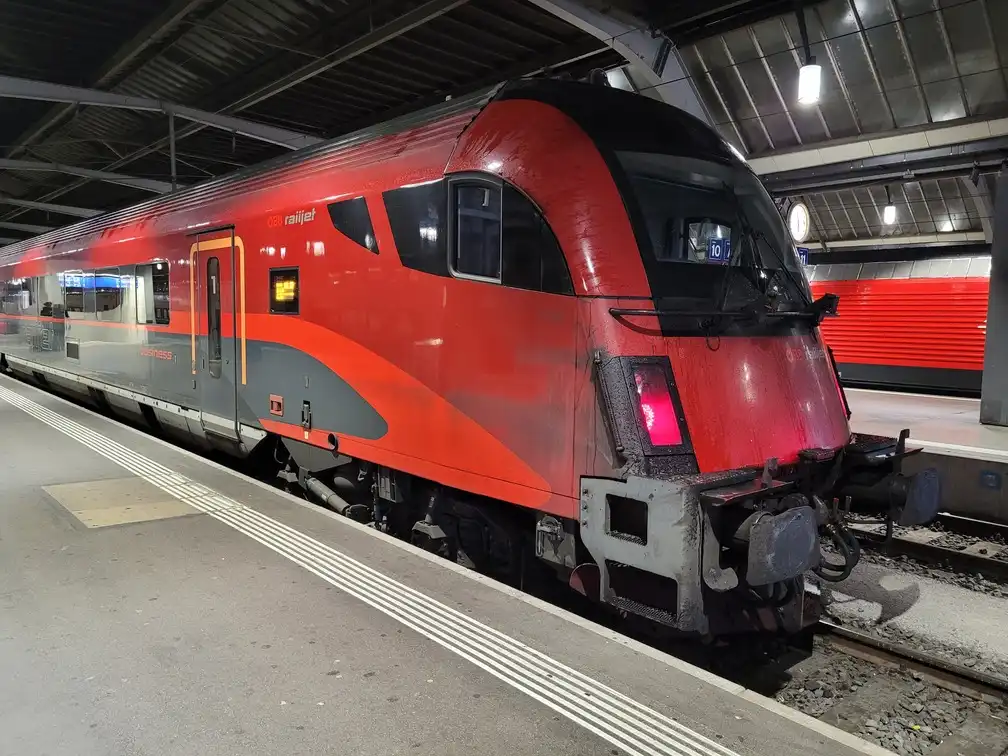 Railjet train operated by ÖBB.
Railjet train operated by ÖBB.
Notably, there is a space for assembled bicycles with mandatory reservation at the end of the train on the second class side. If you go that route, you can book a bicycle ticket + reservation on ÖBB’s website. It’s possible to buy a standalone bicycle ticket, convenient if you’re traveling with Interrail. Pricing appears to be a fixed 3€ reservation fee for the bicycle space, plus a bicycle ticket that varies with the distance (e.g. I’ve seen 10.30€ for Zurich-Innsbruck and 15.30€ for Zurich-Vienna).
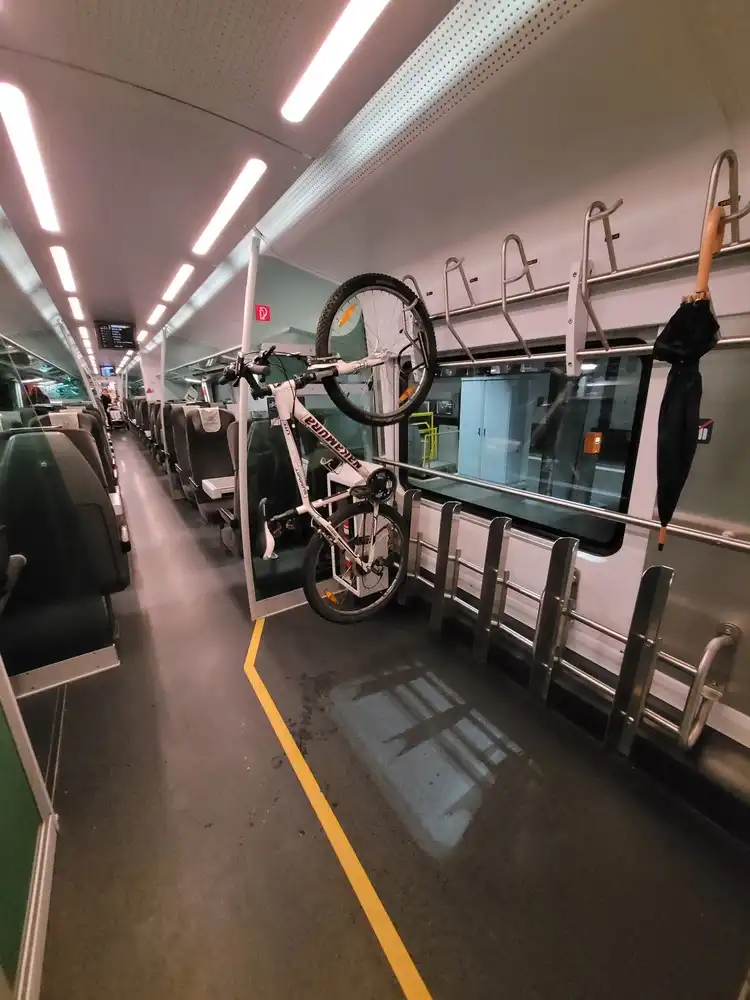 Bicycle space at the end of the Railjet train: 5 vertical spots.
Bicycle space at the end of the Railjet train: 5 vertical spots.
 Seats reserved for cyclists next to the bicycle space.
Seats reserved for cyclists next to the bicycle space.
Unfortunately, there appears to be little space for packed bicycles, and the policy limits packed bicycles to 110x80 cm, which realistically is very restrictive even when removing both wheels.
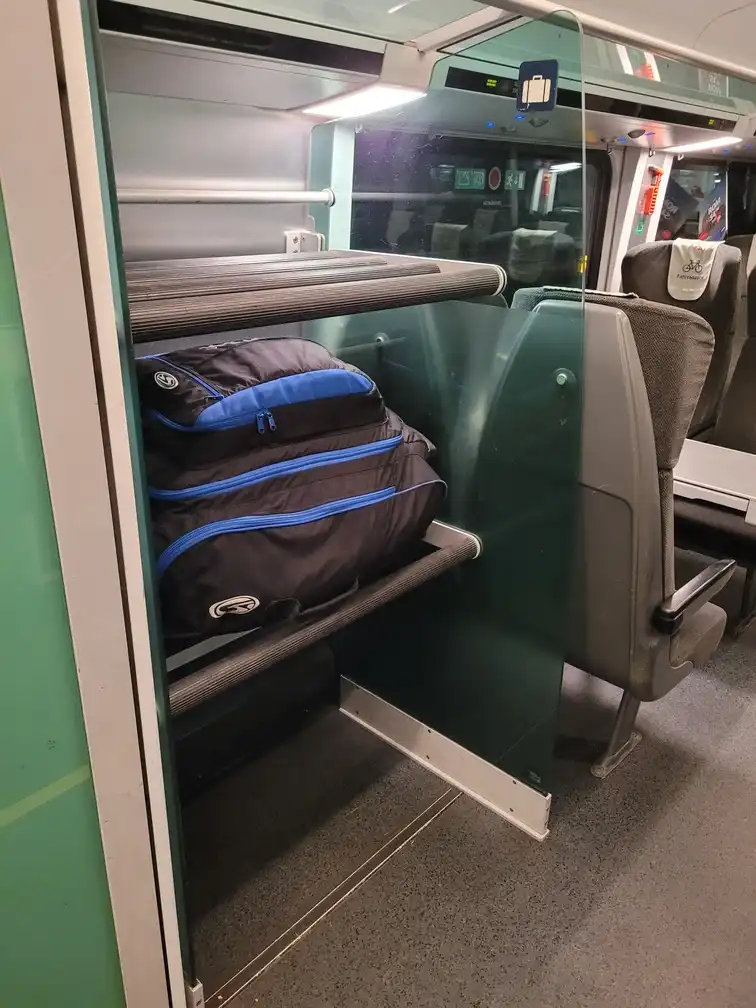 Typical luggage rack in a Railjet train: likely too small for a packed bicycle.
Typical luggage rack in a Railjet train: likely too small for a packed bicycle.
Another option is to take the Zurich-Munich service (see the section about Germany) until Bregenz in Austria, and continue with Austrian trains (which will likely be Railjet as well). There are also regional trains Buchs-Feldkirch (passing through Liechtenstein) and St Margrethen-Bregenz.
France
See also the page dedicated to France to continue your journey there.
There are two groups of trains between Switzerland and France.
- High-speed trains between Paris and either Geneva-Lausanne or Basel-Zurich, operated by TGV Lyria (a subsidiary of SBB and SNCF).
- Regional trains operated by SNCF, the main ones are Geneva-Lyon, Geneva-Grenoble-Valence and Basel-Mulhouse-Strasbourg.
The high-speed trains from Lyria are pretty much the same as TGVs offered by SNCF within France (apart from the logos), and the Lyria fleet should now only contain Duplex TGVs. As such, the rules to bring bicycles are practically the same as SNCF: transporting assembled bicycles isn’t possible, and disassembled bicycles can be brought free of charge but must fit within a package of 130x90 cm.
This means that only the 2-wheels removed solution should be accepted, contrary to the Swiss rules that are more permissive. That said, I’ve successfully managed to bring a bicycle in a front-wheel-removed TranZbag a handful of times by making sure to store it where it doesn’t block the way, but of course there’s no guarantee you won’t get fined or rejected from the train if you do that.
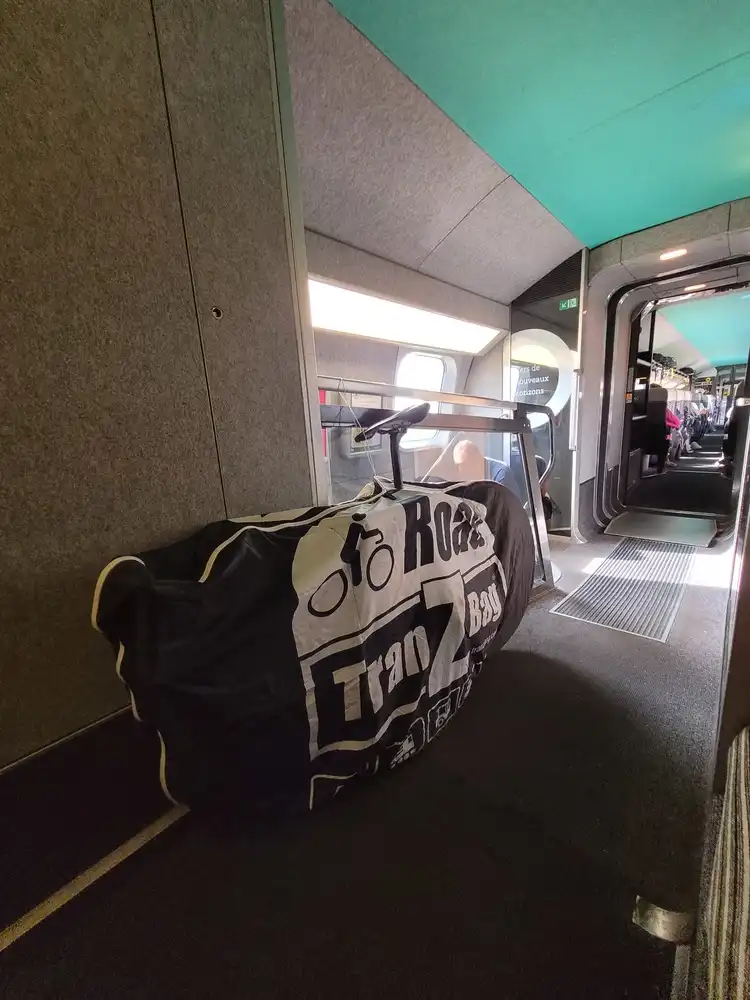 Upstairs corridor in a TGV Duplex.
Upstairs corridor in a TGV Duplex.
Bringing a bicycle on the main French regional trains from Geneva or Basel is more straightforward: no reservation nor bicycle ticket needed, whether the bicycle is assembled or not. The older Corail trains (mostly from Basel) have a couple vertical hooks at some doors.
The packed bicycle method isn’t ideal, as it gets in the way when put horizontally, but you can still use it if you’re connecting with another train where it makes sense.
The newer AGC and 2N-NG models have spaces that combine 5 or 6 vertical hooks with foldable seats.
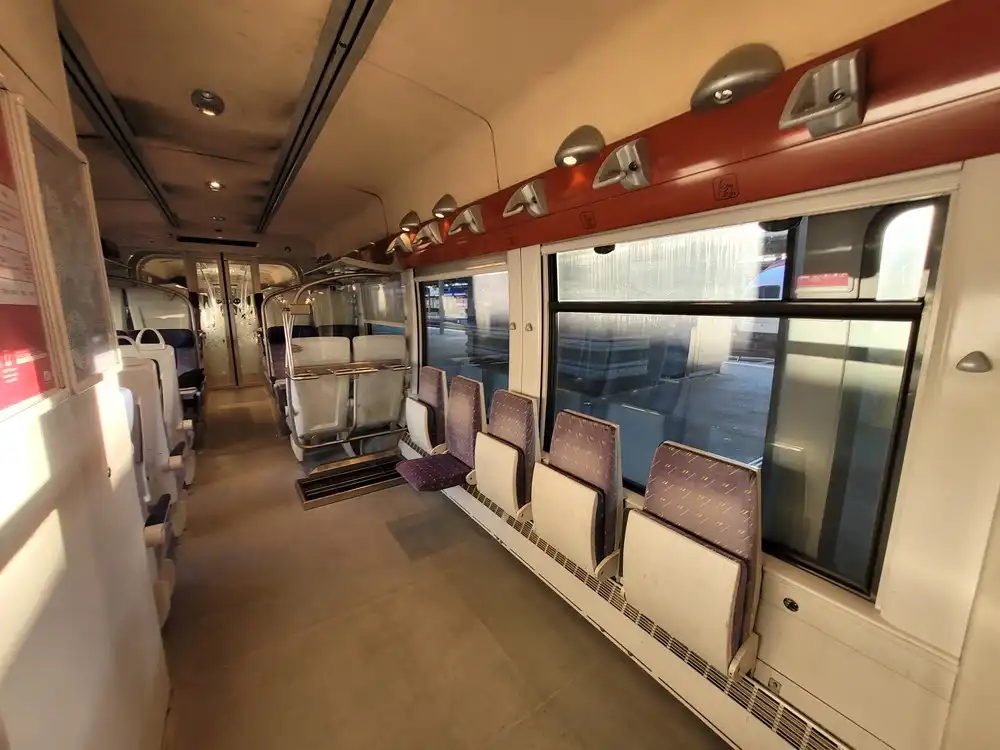 Bicycle space in an AGC train.
Bicycle space in an AGC train.
 Bicycle space in a TER 2N-NG train.
Bicycle space in a TER 2N-NG train.
Germany
Not all trains between Switzerland and Germany have spots for assembled bicycles, and as usual SBB won’t help you to get a bicycle ticket on an international train. However, you can use the Deutsche Bahn website or the DB Navigator app (Android, iPhone) to check which trains have space and purchase the bicycle ticket. The nice thing is that you can buy a standalone bicycle ticket (just replace “person” by “bicycle” in the search bar), which is convenient if you’re traveling with Interrail. Each journey has a different price and I couldn’t find clear information about pricing rules, other than that a bicycle ticket costs between 7.50€ and 12.90€ within Germany and at least 7.50€ for international journeys (FAQ in German).
Looking in more detail, there are two main routes between Switzerland and Germany.
- The Basel-Frankfurt line along the Rhine valley with extensions towards Zurich-Chur or Bern-Interlaken in Switzerland, and towards Hamburg or Berlin in Germany.
- The Zurich-Munich line.
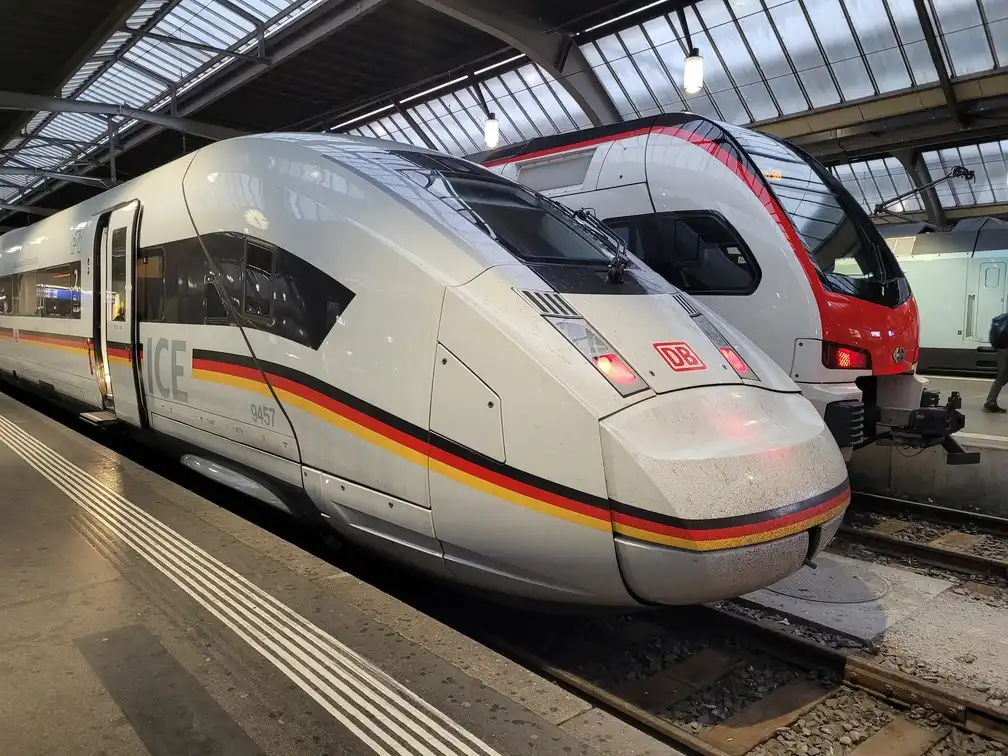 The newest ICE 4 train from Deutsche Bahn.
The newest ICE 4 train from Deutsche Bahn.
Trains towards Frankfurt use ICE trains from Deutsche Bahn and therefore have similar conditions as most long-distance routes in Germany. In particular, the interior should be spacious enough for packed bicycles if you find the wider luggage racks. Some newer trains (ICE 4) also provide a room for assembled bicycles (don’t forget to buy the additional bicycle ticket and reservation with Deutsche Bahn).
Pro tip: Deutsche Bahn publishes detailed PDFs with the floor plan of its trains as well as 360° virtual tours, so you can take a look if that makes you more comfortable or helps you choose seats next to the best luggage spots.
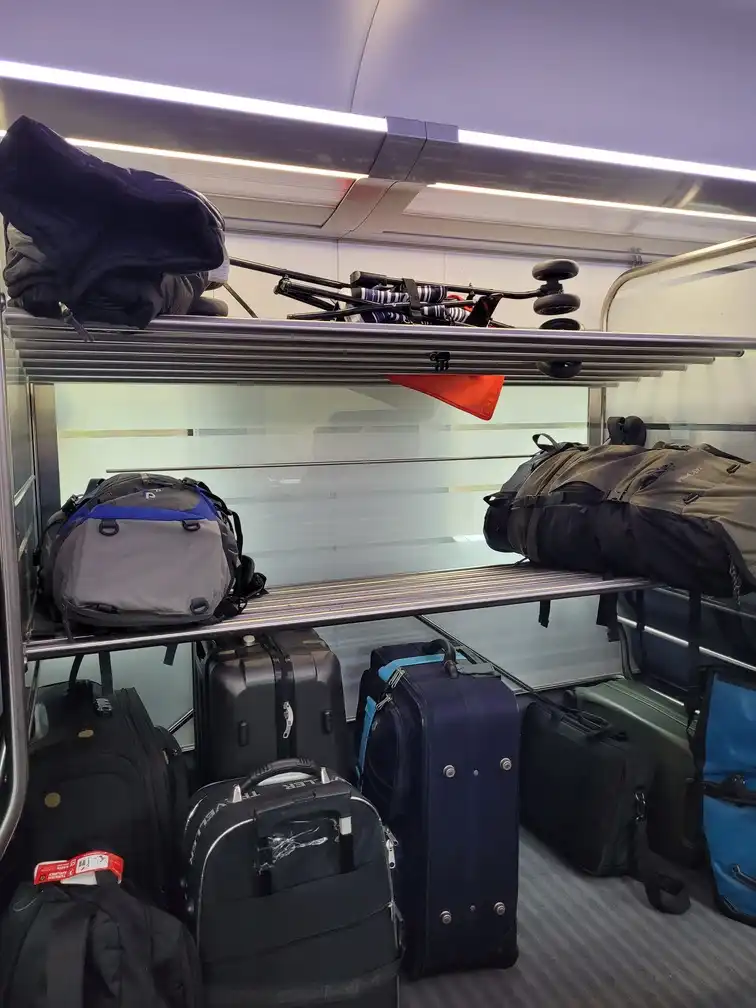 Larger luggage rack available on some trains.
Larger luggage rack available on some trains.
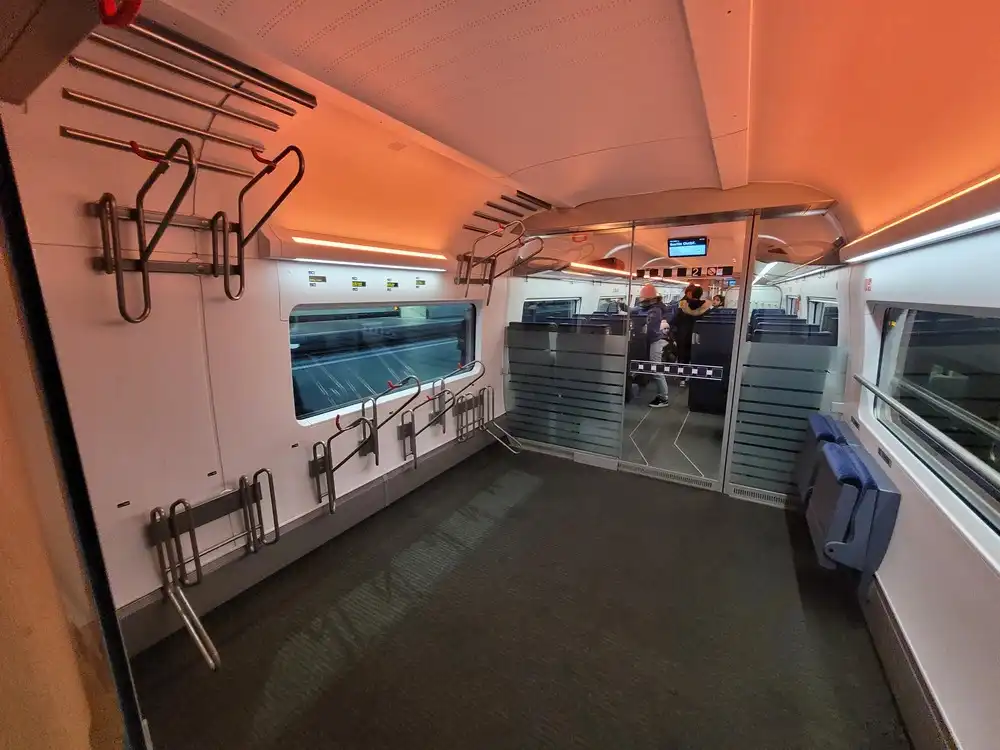 Bicycle room in the newer ICE 4.
Bicycle room in the newer ICE 4.
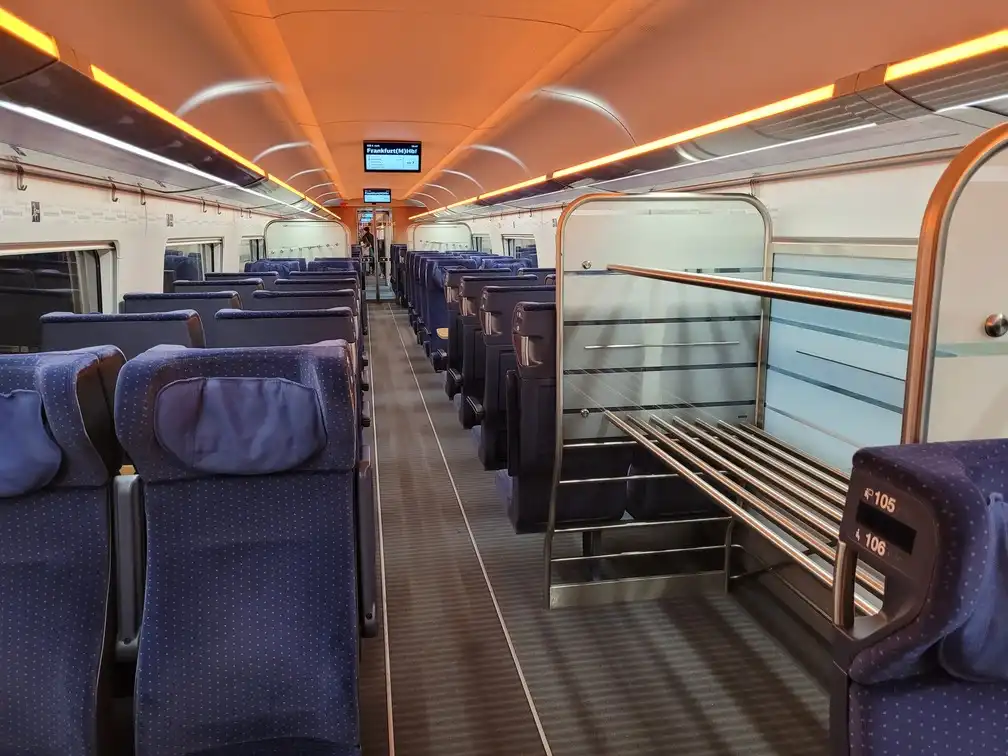 Many large luggage racks are available in ICE 4 trains.
Many large luggage racks are available in ICE 4 trains.
Trains towards Munich use New Pendolino trains (branded as “Astoro” by SBB), which have very little space for luggage (small overhead space, no luggage racks between seats). They do have a few spaces for assembled bicycles next to the entry doors of some carriages, but you definitely need to reserve them as they otherwise fill up with luggage that other passengers cannot put at their seats. These luggage racks next to the doors would also be where you’d put a packed bicycle – although I don’t have experience bringing a bicycle on board those trains.
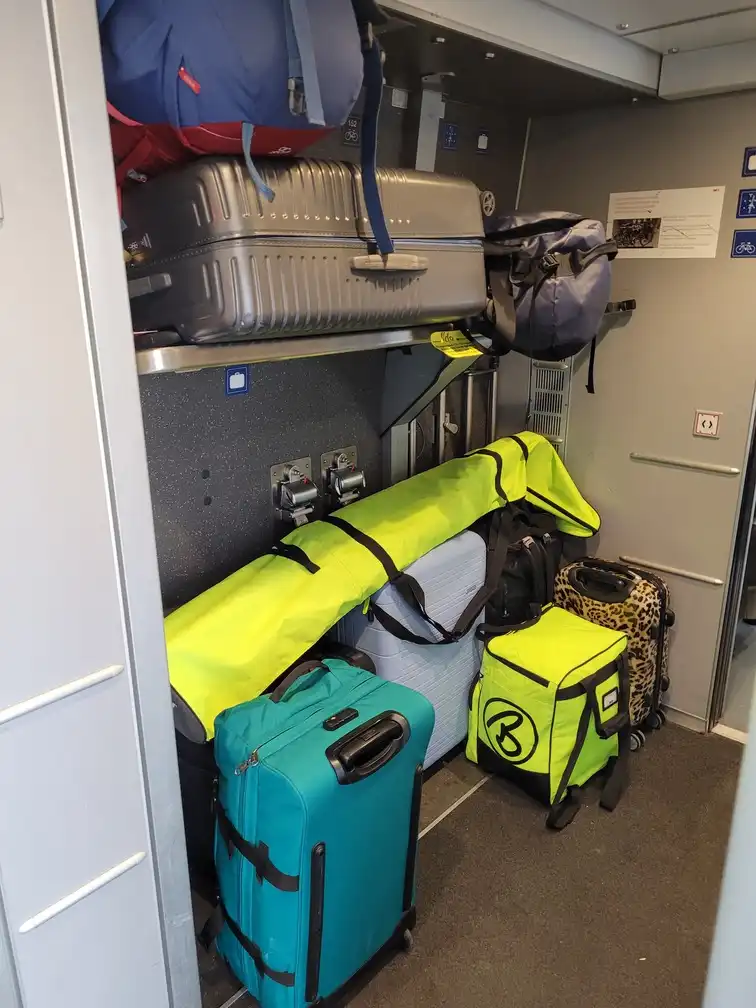 Bicycle space in a New Pendolino train, with luggage this time.
Bicycle space in a New Pendolino train, with luggage this time.
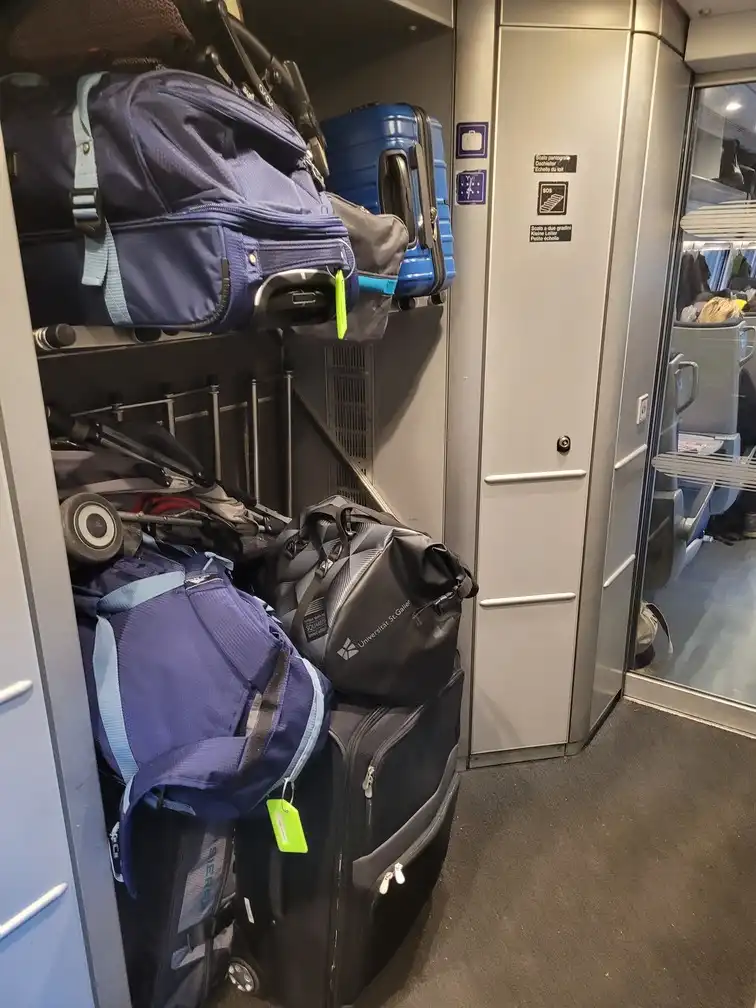 Luggage space in a New Pendolino train.
It’s shorter than the bicycle space.
Luggage space in a New Pendolino train.
It’s shorter than the bicycle space.
Additionally, some Frankfurt-Zurich services cross all of Switzerland until Milan and use the “Giruno” train model, see the section about Italy.
Italy
Direct trains connect the major Swiss cities with Milan in Italy, sometimes extended to Genoa, Bologna or Venice. They cross the Alps via one of two tunnels: the Simplon at the border next to Brig or the Gotthard in the middle of Switzerland.
The Simplon tunnel is used by trains from Geneva/Lausanne or Basel via Bern, and is served by Astoro trains. The train interior is very similar to the Zurich-Munich route, so I’ll refer to the section about Germany – the only difference is that you’ll have to book spots for assembled bicycles with Trenitalia.
The Gotthard tunnel is used by trains from Zurich or Basel via Luzern, sometimes extended to Frankfurt in Germany. Since the opening of the Gotthard Base Tunnel in 2016, a newer train model named Giruno is being deployed for these services. This single-level train provides large spaces for luggage and bicycles. Assembled bicycles require a reservation, which SBB doesn’t sell. You can book your bicycle spot via Trenitalia, which will cost 12€. This bicycle ticket can be added before the payment stage, which means that it must be bundled with a regular ticket purchase (so you can’t buy it when using Interrail for example). It is also possible to buy the bicycle spot on board, but only for the Italy to Switzerland direction.
There is however a lot of space for packed bicycles and luggage in general, and the bicycle spots are not always all taken (perhaps because reserving spots is so hard) so you may try them if no bicycle shows up. Lastly, there are foldable seats like in most Swiss intercity trains, so if your train isn’t busy you can use this space too.
Planning your cycling route
Switzerland is a contrasted country. It has one of the densest public transport systems in the world, but also one of the densest highway networks (tunnels included). Many live car free, many drive SUVs. An extensive network of cycling routes crosses beautiful landscapes around the country, but cycling infrastructure is often poor in the cities.
Therefore, planning your cycling route is essential to make your experience as pleasant as possible. My main advice would be to stick to the official network of cycling routes, available in road cycling and mountain biking versions. You can browse the map on the Switzerland Mobility website and on its corresponding app (Android, iPhone). The official network isn’t perfect (some sections are a stripe on the road, some sections are unpaved for kilometers) but covers most of the country and is excellently marked.
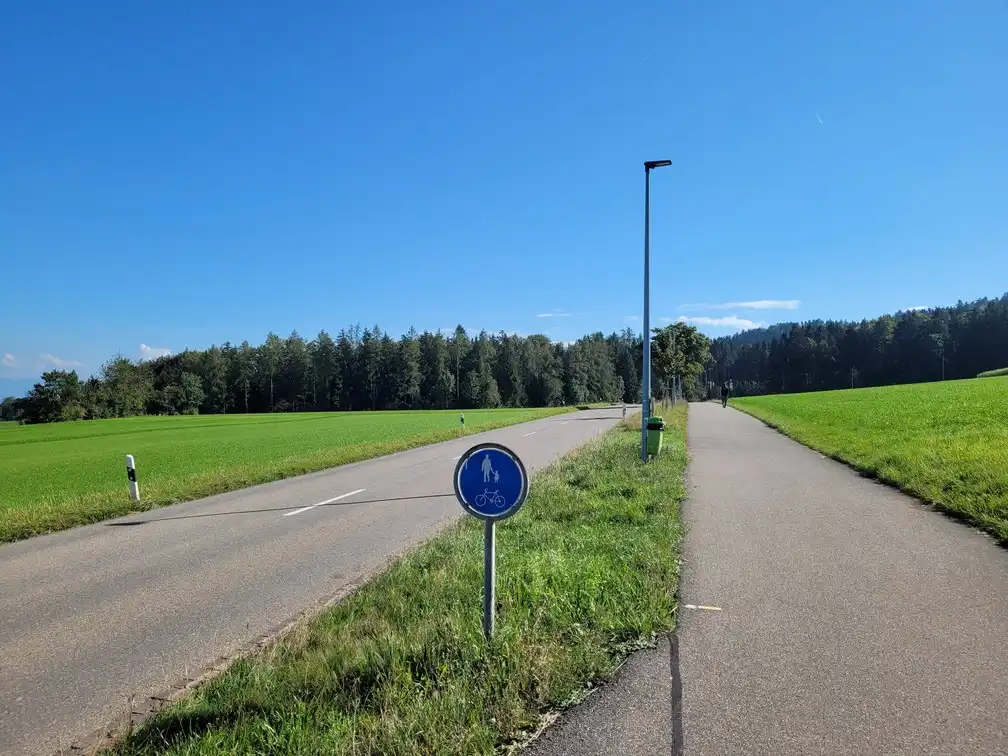 Typical separated cycling + pedestrian path along a road.
Typical separated cycling + pedestrian path along a road.
In the field, follow the burgundy red signs for the route number you’re using, which give directions very regularly at each intersection.
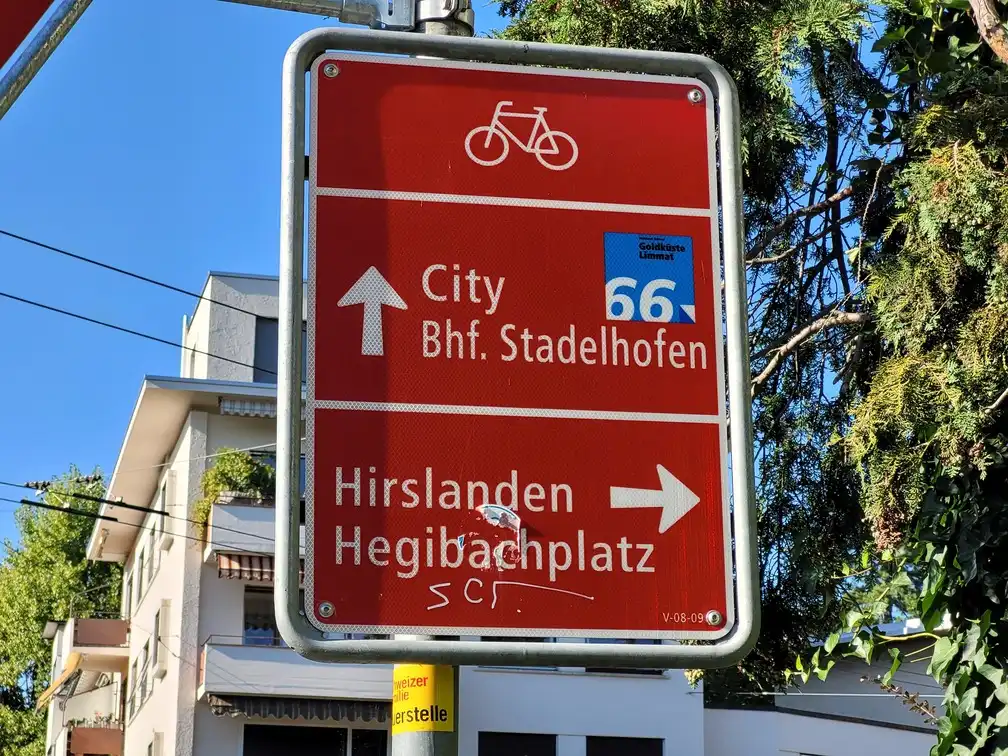 Signs along cycling routes in Switzerland.
The main routes each have a number that you can follow.
Signs along cycling routes in Switzerland.
The main routes each have a number that you can follow.
Pro tip for road bike users: gravel sections are marked as a dashed blue line in the Switzerland Mobility map and paved sections with a continuous blue line (you need to zoom enough in the map to see the dashed pattern though).
Diversions and closures due to maintenance works or other reasons are very well indicated, both in the app and in the field.
If you’re planning to ride on the main mountain passes, I’d recommend avoiding sunny week-ends in the summer months, as the motorized traffic is high. Prefer weekdays or the autumn: most passes are open all of October and part of November (apart from occasional early snow). You can check current and historical openings on alpen-paesse.ch.
Additionally, most passes have a yearly event (for example Ride the Alps) where they are closed to motorized traffic and reserved to bicycles. Such events are generally free and although the amount of bicycles is definitely high it will be a nice experience away from motor noise.
Enjoy your riding!
